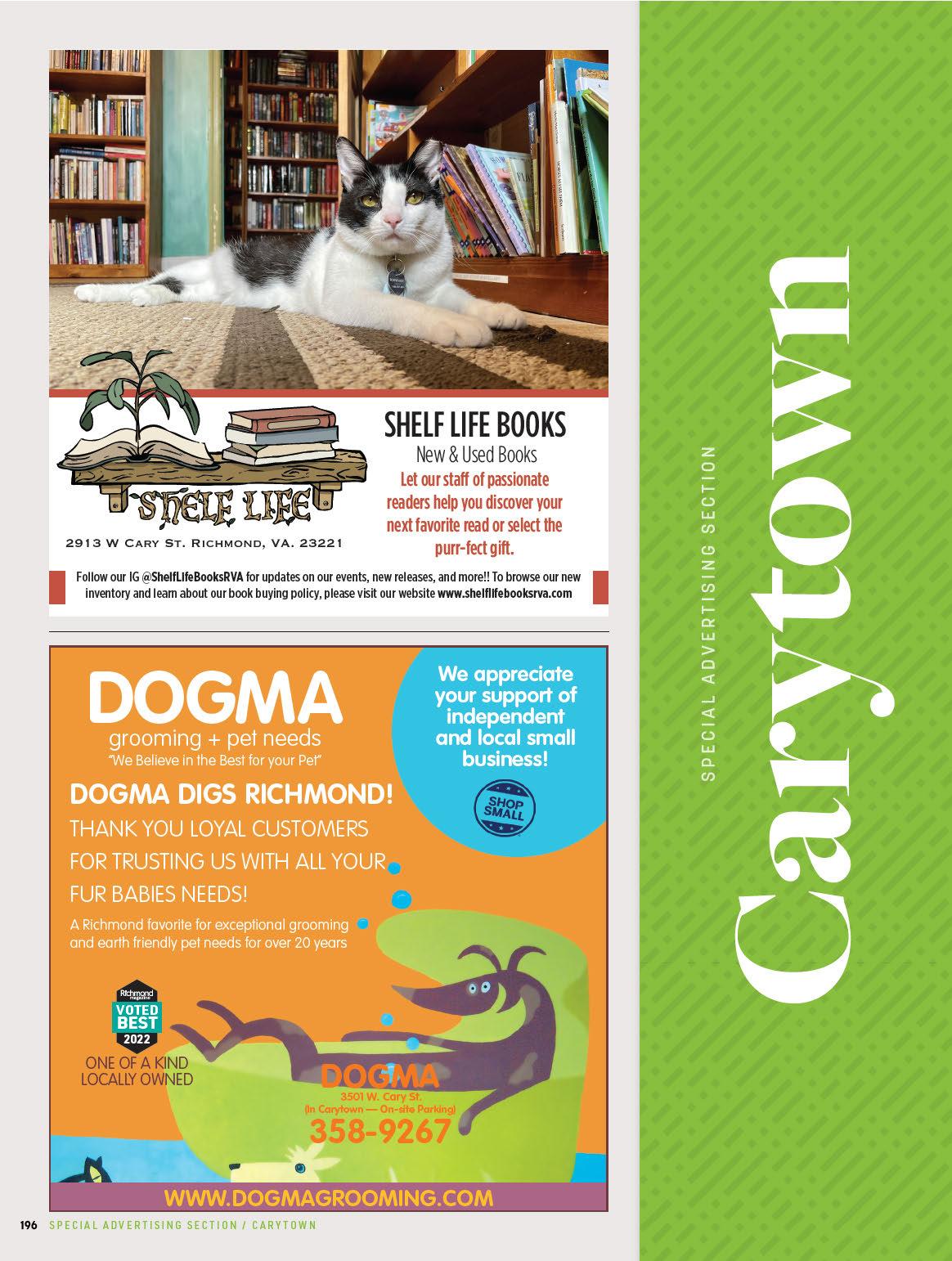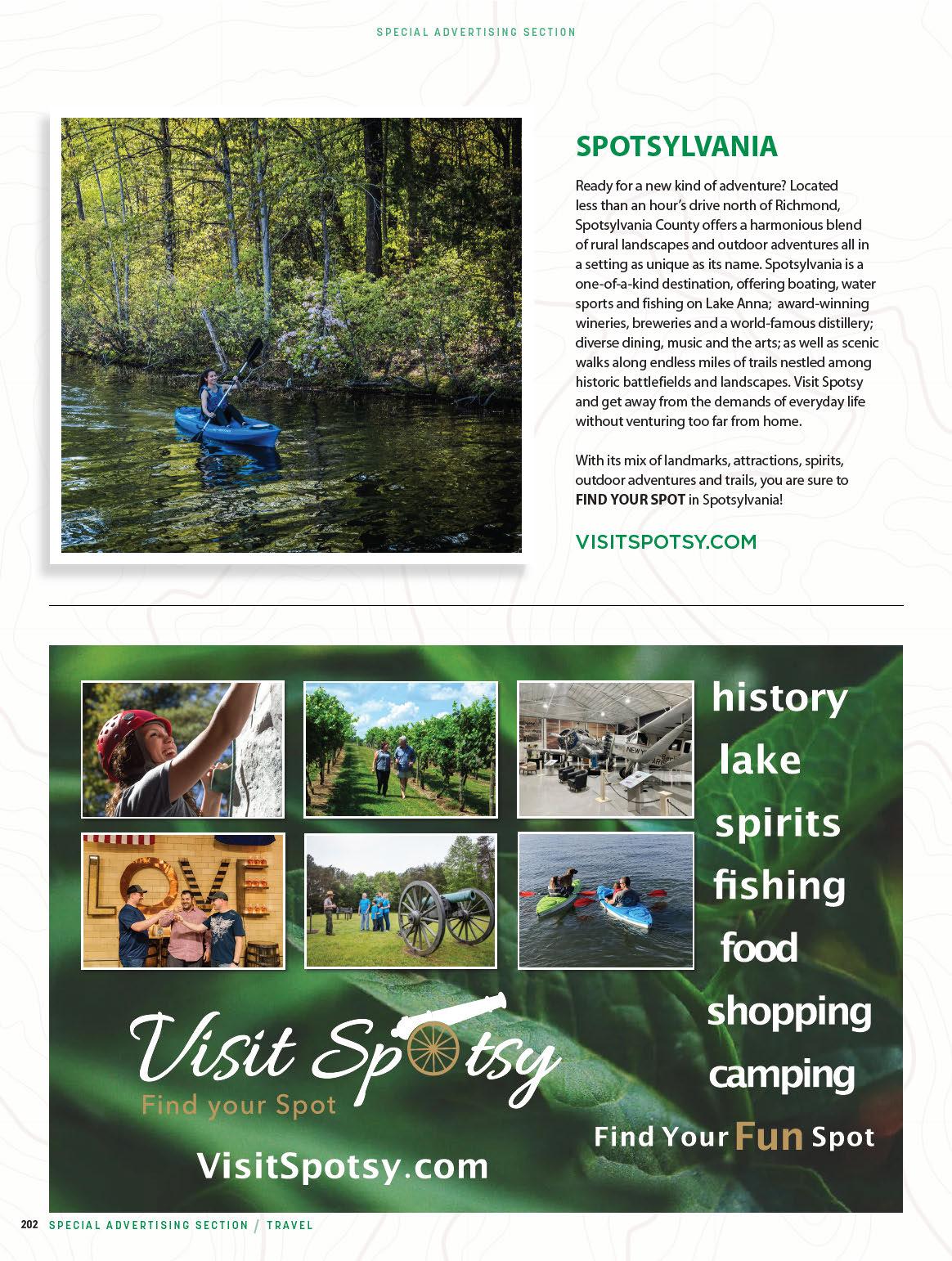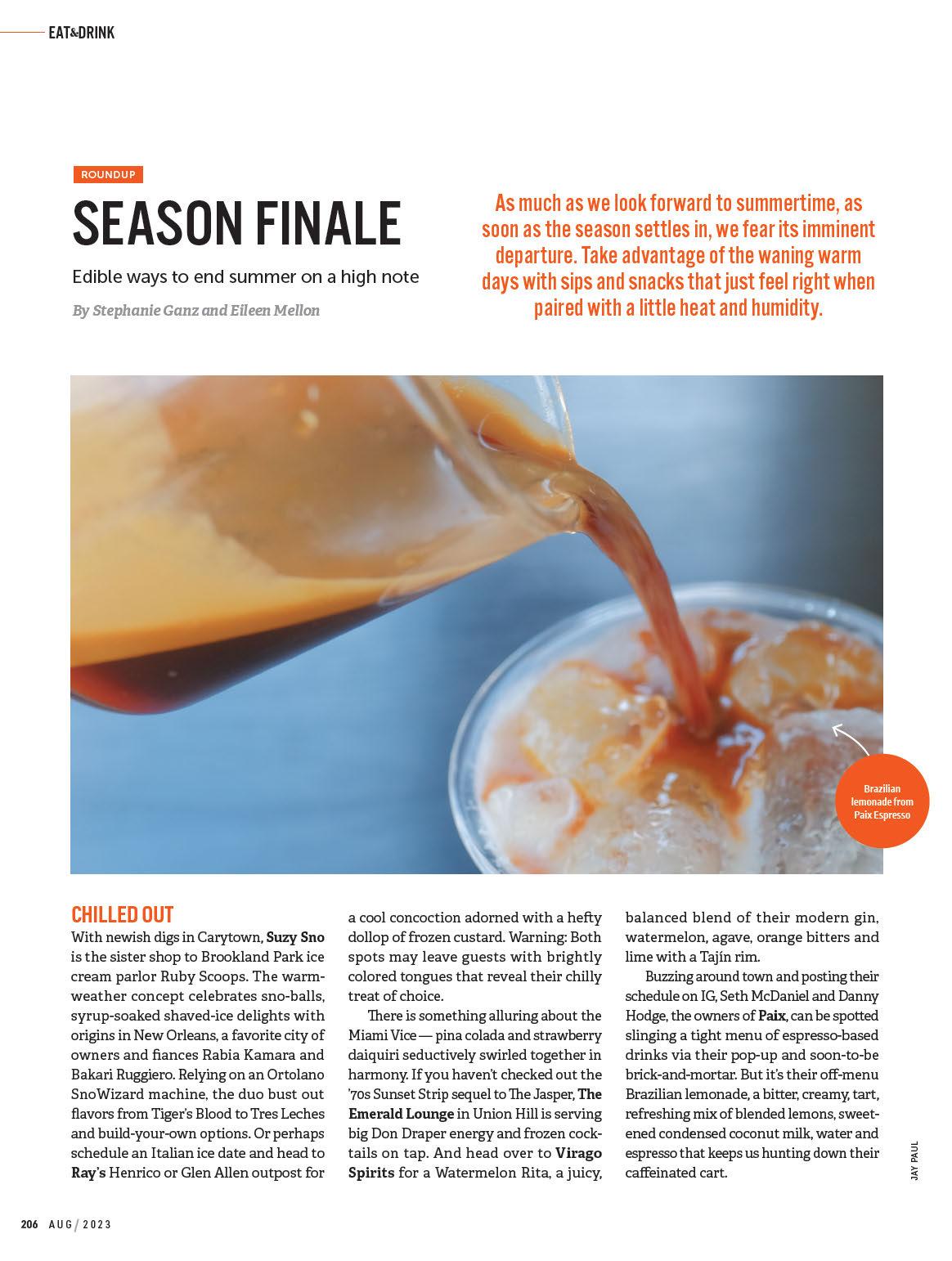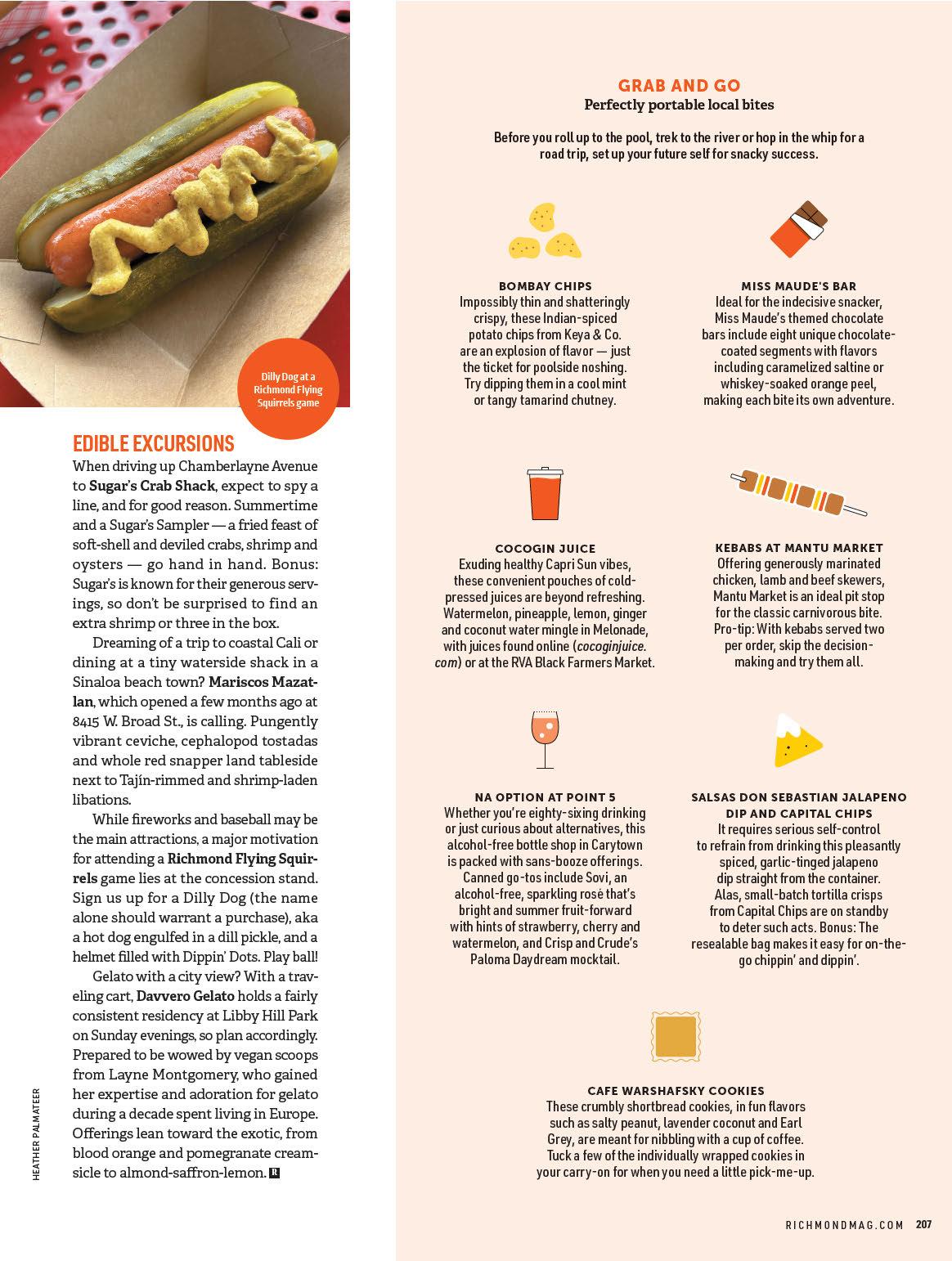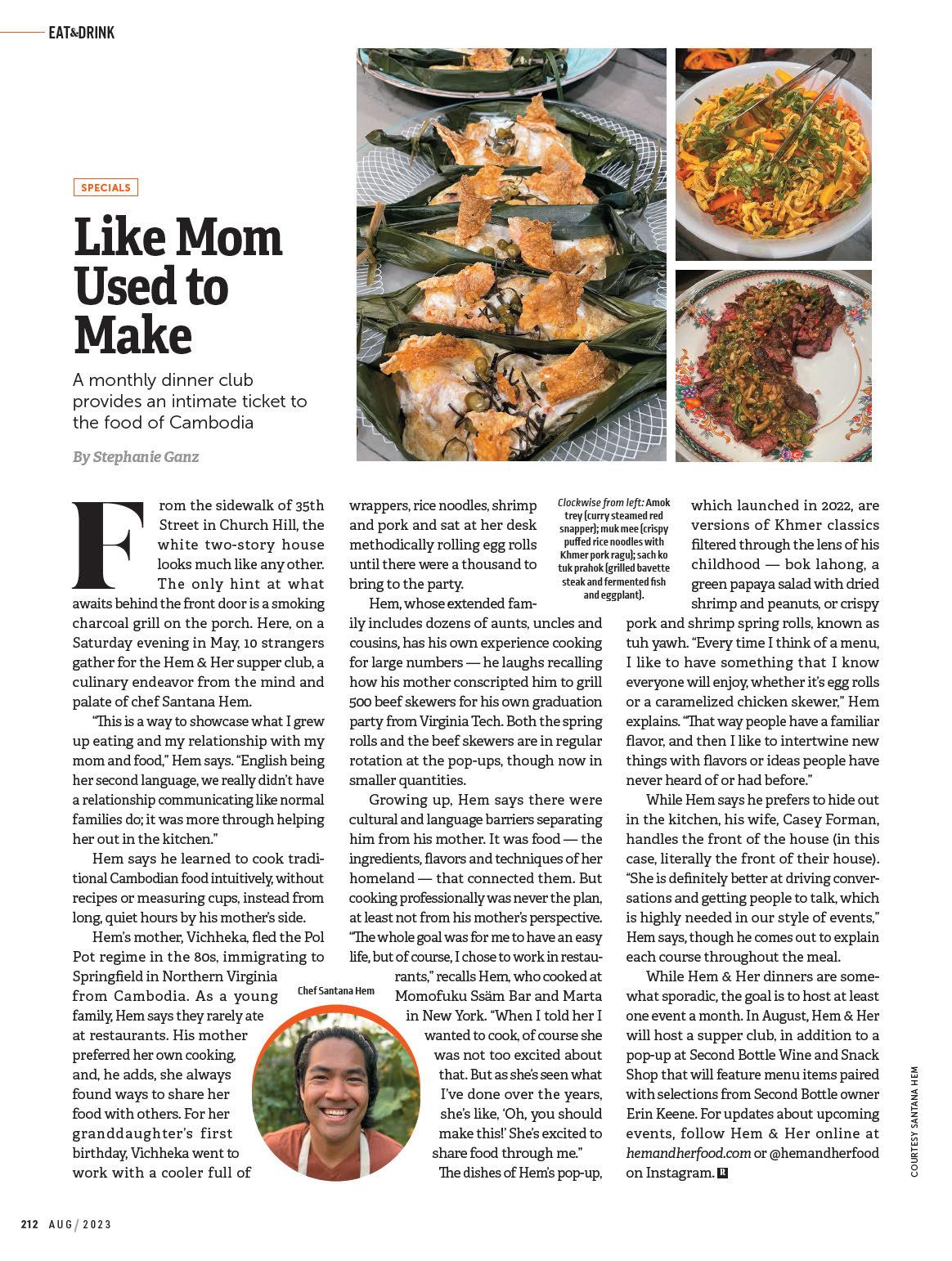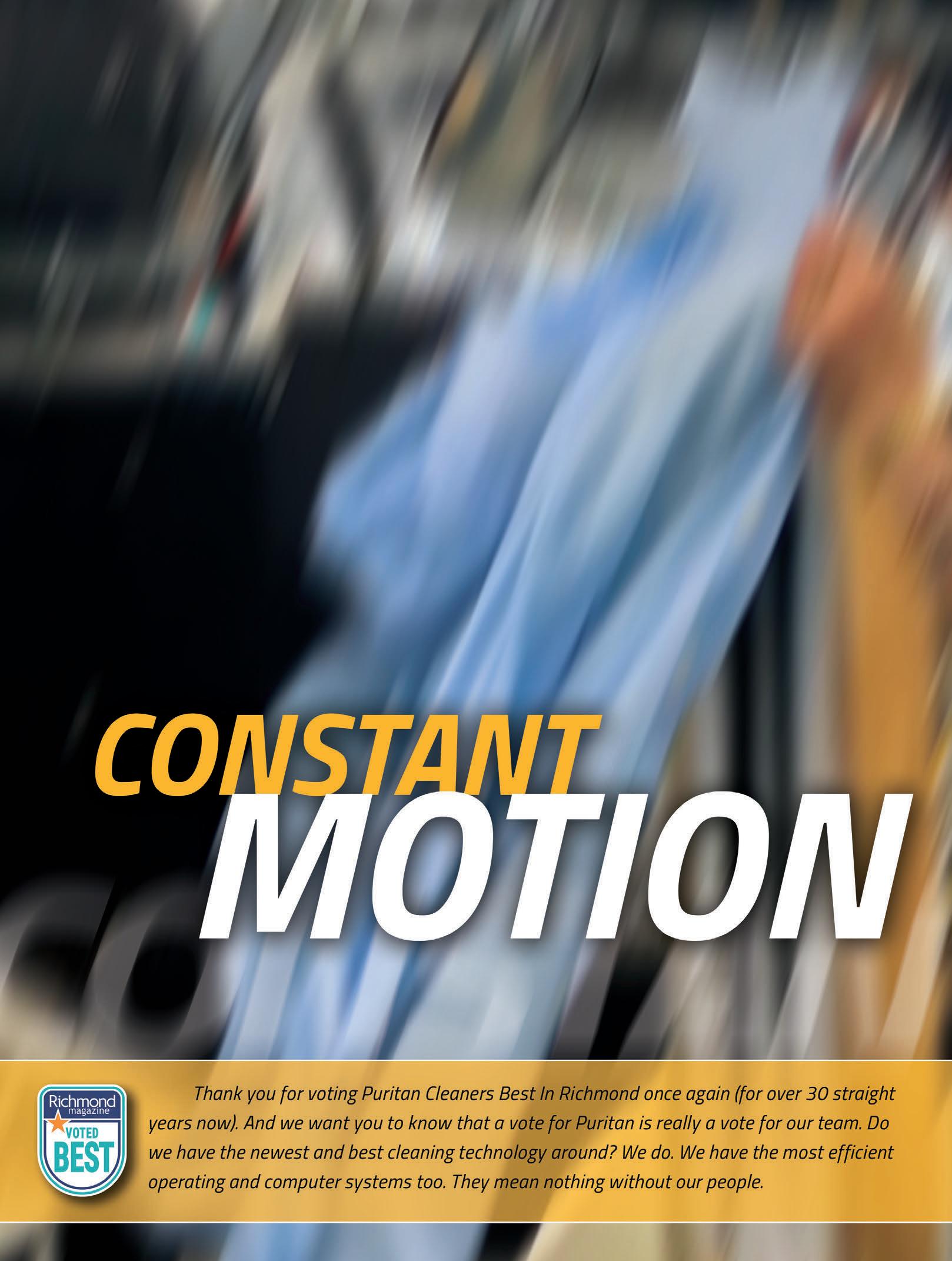




































Flower farming is making a comeback. Meet the gardeners growing a local niche, explore a flower exchange and visit a farm bursting with 200,000 daylilies.
 By Claire Fortier & Emily Richardson
By Claire Fortier & Emily Richardson
For our 36th annual Best & Worst issue, we present readers’ picks across 200 categories — services, stores, restaurants and more — as well as Richmond’s lessthan-stellar aspects, from tra c jams to political drama.
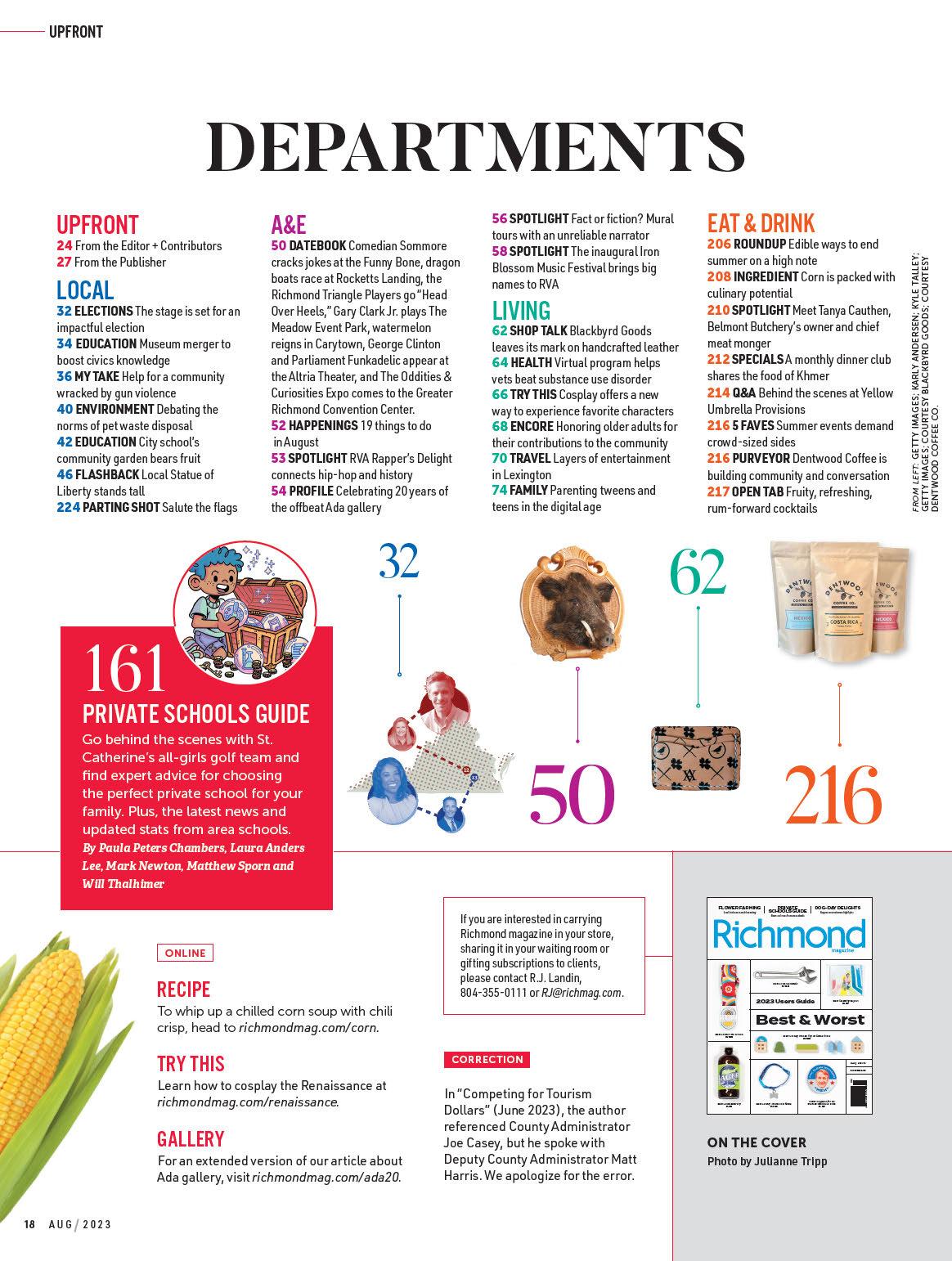





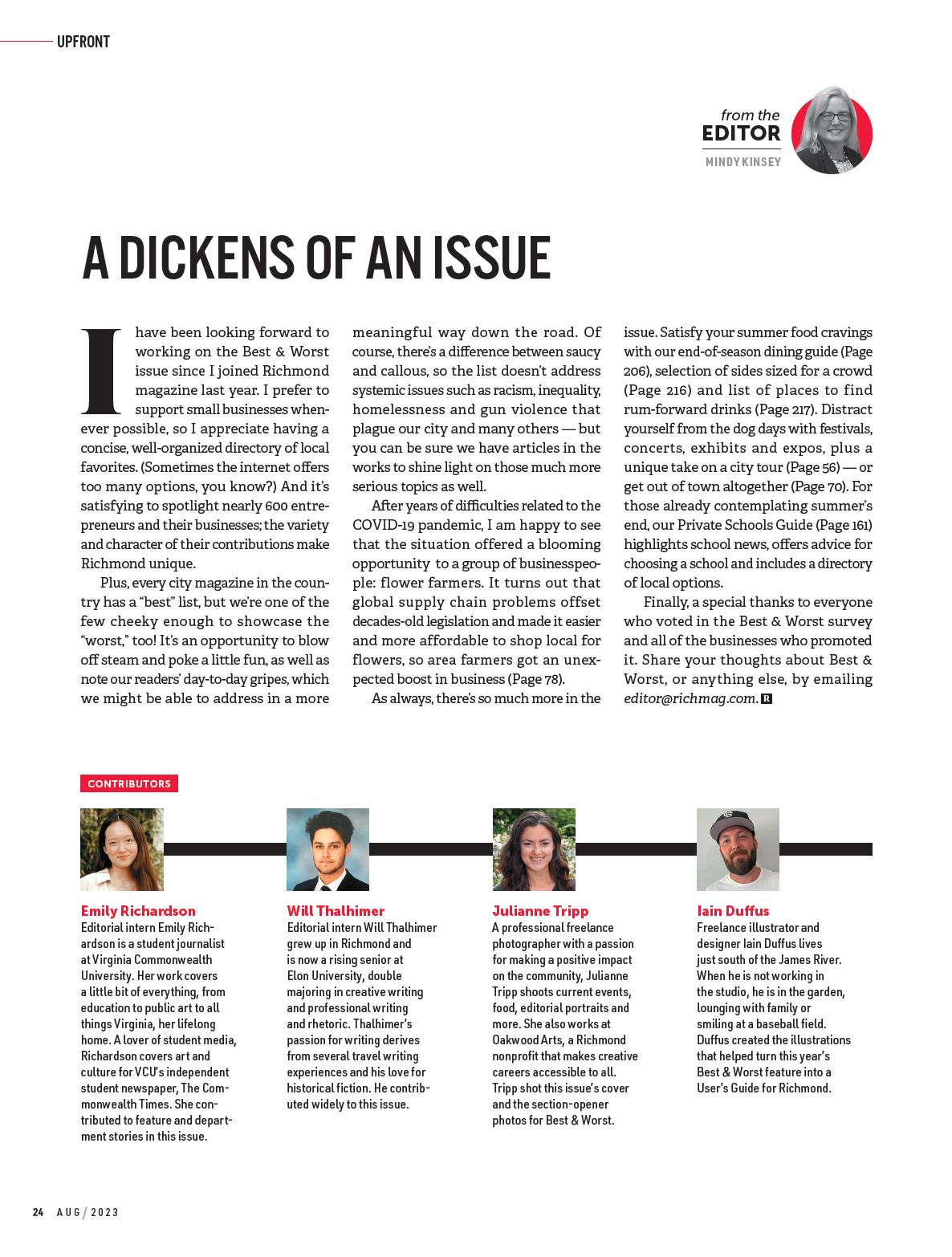


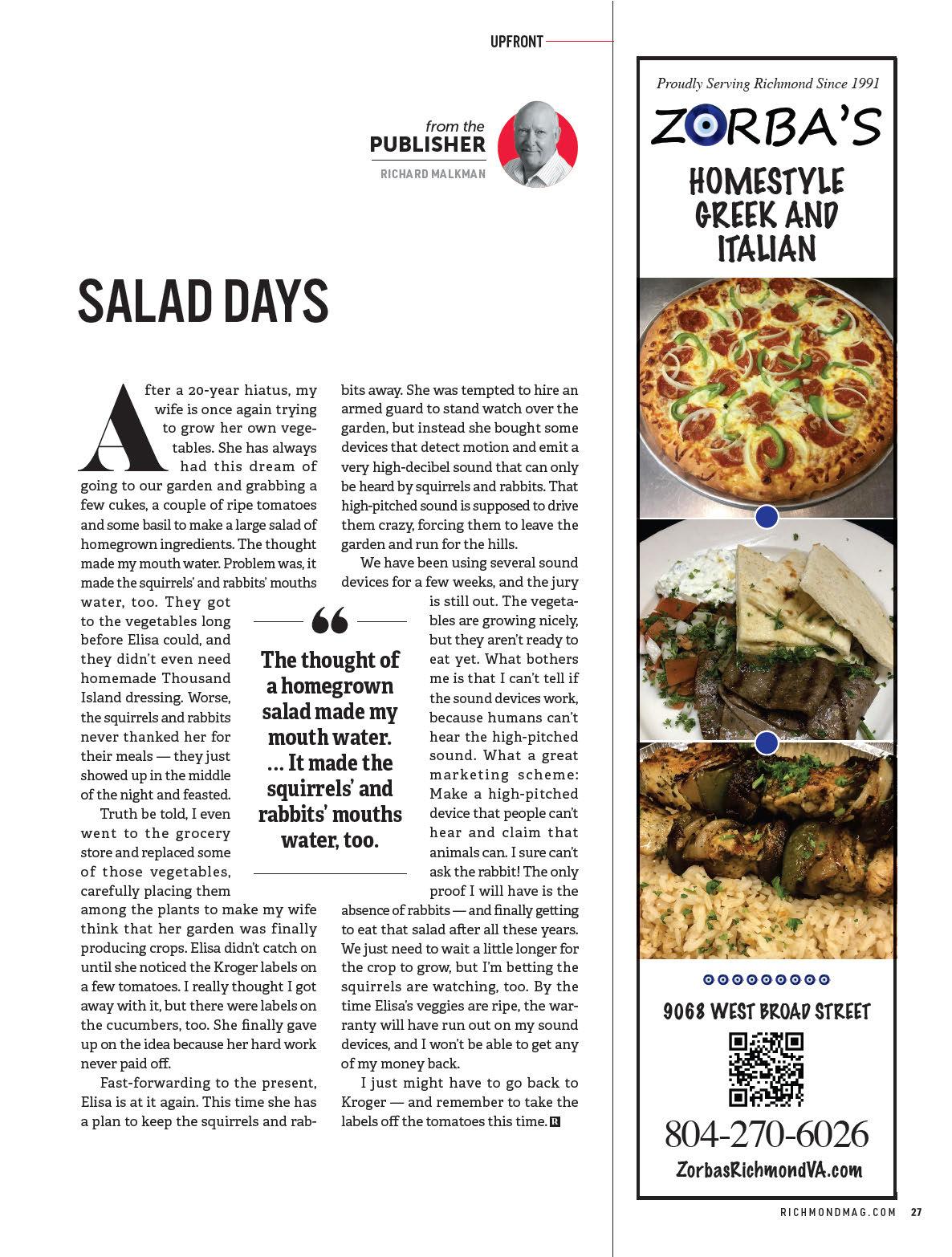


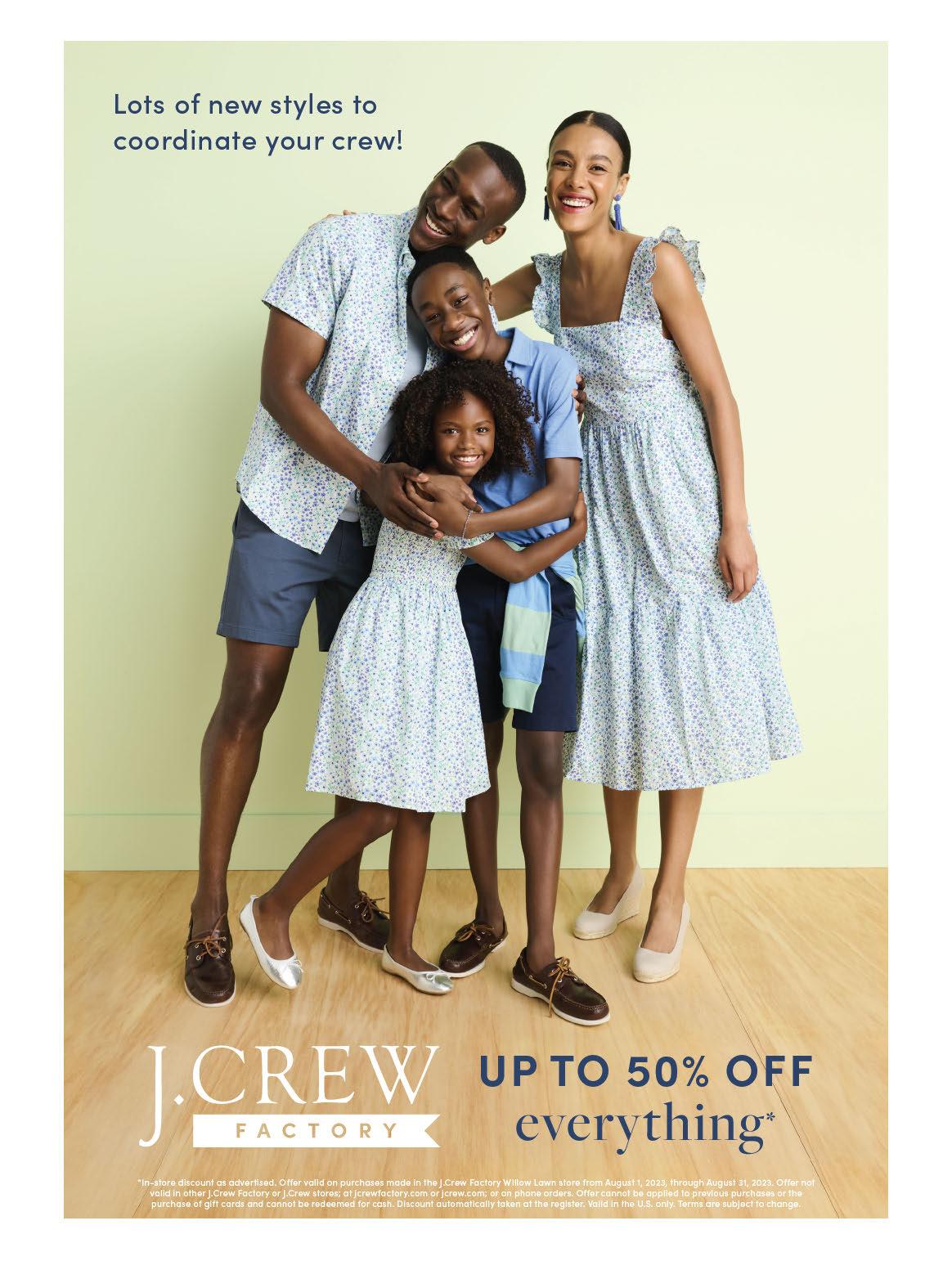









It’s generally held that you should pick up a er your pet — signs sca ered throughout Richmond also threaten a $250 fine for not doing so.

But exactly where dog poop should be disposed is a topic of debate. ere are places it shouldn’t go: on the ground, down a storm drain or in a waterway. Megan Brown, who works for Henrico County’s Department of Public Utilities, says that a lot of bagged pet waste ends up in storm drains. “You have to finish the process,” she says. “You did great. You picked it up, now you have to take it to the end.”
But some believe that any garbage can will do, while others argue that the only place it should go is the owner’s own trash. And many wonder why someone cares what goes into a garbage can at all.
It may help to think of the debate in terms of both city ordinance and social etique e. In the city of Richmond, pet waste is considered the responsibility of the owner and should be disposed of in a container that is sealable, rat-proof and fly-tight, according to municipal code. is means you’re only supposed to use a a public trash can with a top or one of those big green cans emptied weekly by the trash collectors, called supercans, which are the property of the city and are supposed to be used only by the occupant of that property.
On etique e, Richmonders disagree. There’s a sizable constituency that would rather see the poop in their
supercan than in their yard, on the sidewalk or, heaven forbid, underneath their shoe. Those opposed to tossing poop bags in the nearest trash can complain of bags that aren’t properly tied or that break, leaving a nauseating mess. Some residents keep their cans on private property, and tossing a bag could be tantamount to trespassing.
“For years, there have been ‘poopgate’ ba les on the Church Hill neighborhood Facebook page and on Nextdoor. I just don’t get it,” says Marna Bunger, who lives in the Je erson Park area. “I’m thankful it’s tossed, tied o or not.” Bunger’s supercan sits in an alley that gets a lot of foot tra c, and it seems to attract other people’s garbage.
“Everyone uses my can: to-go food boxes, kids’ drink cups, dog poo, beer cans, whatever.” she says. “I’d rather have it in my can than on the ground.”
If it doesn’t end up in a can, it ends up in our water. While some storm drains in Richmond convey water to the city’s wastewater treatment plant, most drain directly into our waterways, says Justin Doyle, director of community conservation at the James River Association.
Pet waste is a source of E. coli bacteria, Doyle points out, and “if stormwater runo carries bacteria from pet waste into the James River, it becomes stormwater pollution. High levels of bacteria in bodies of water can make it unsafe for swimming and recreation in general.”
Bagging can create its own problem. According to a 2022 study by a team of environmental scientists in Poland, plastic dog poop bags constitute about 0.6% of global plastic waste. One solution is to replace plastic bags with ones that are biodegradable.
Some neighbors, however, are just trying to do their part in keeping their city clean. “I’m amazed at how many people don’t scoop up the dog poop,” says Rachel Boxill, a dog owner in the Museum District. “I usually end up scooping up somebody else’s along with my dogs’ just because I don’t want people to step in it.” R



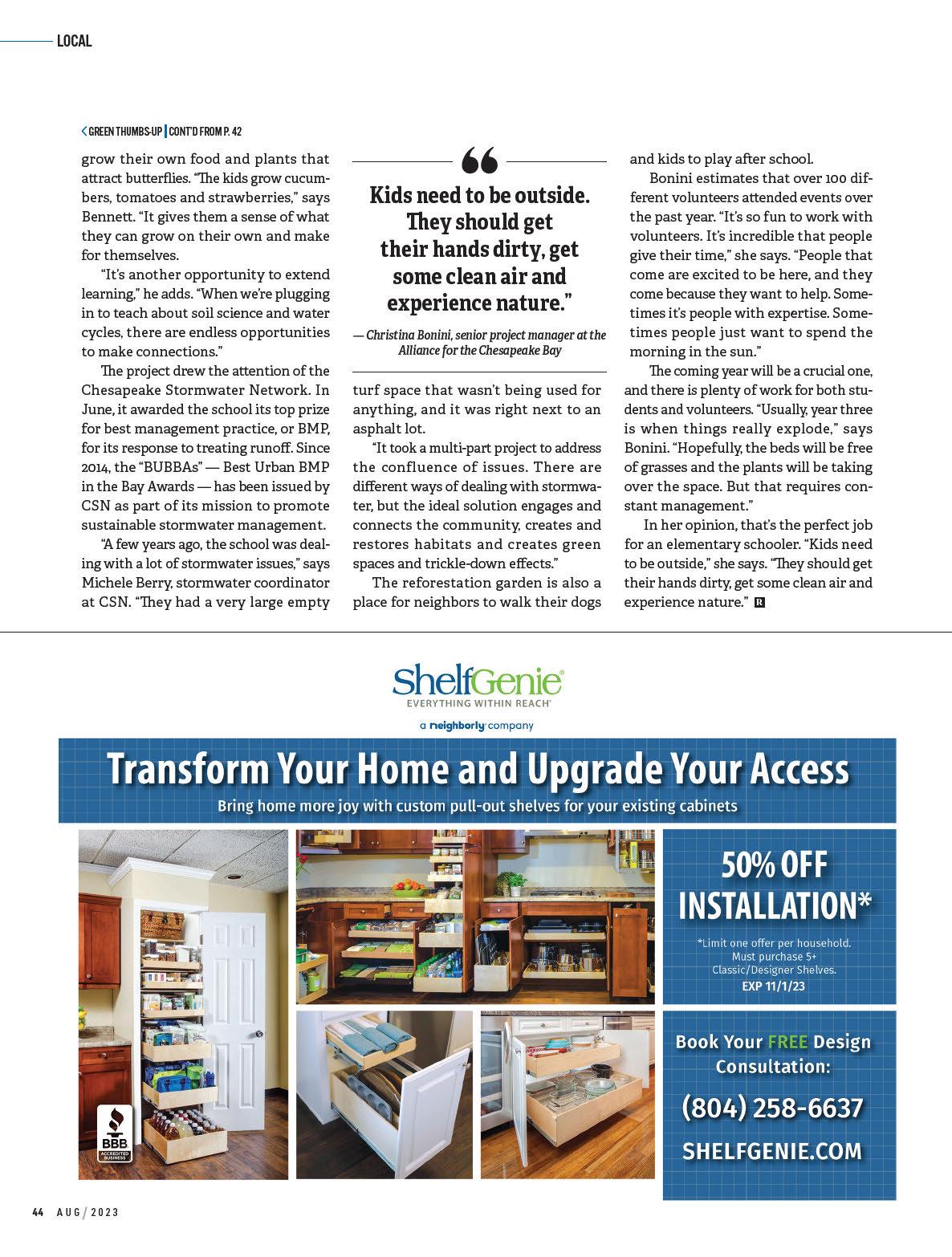









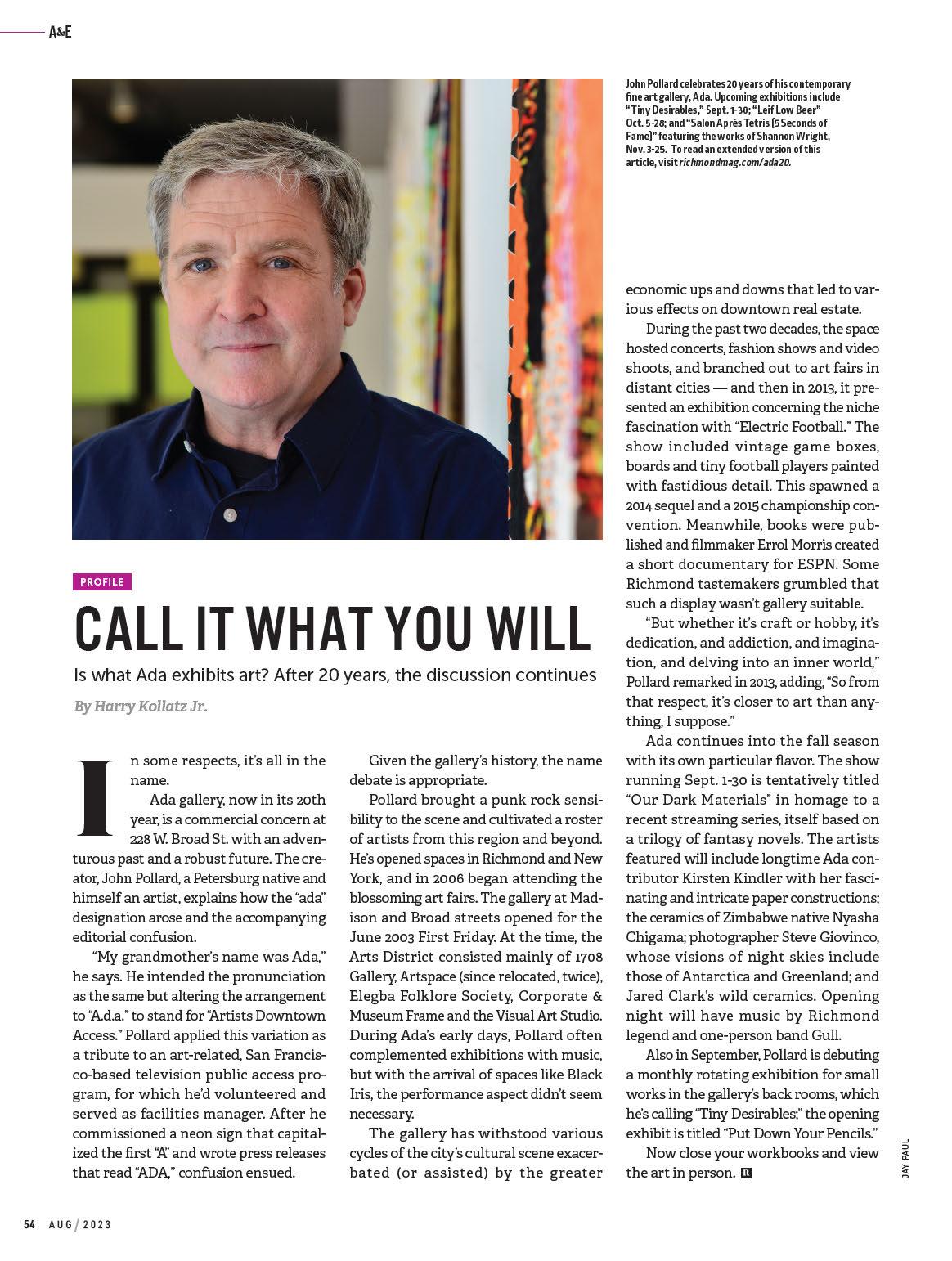





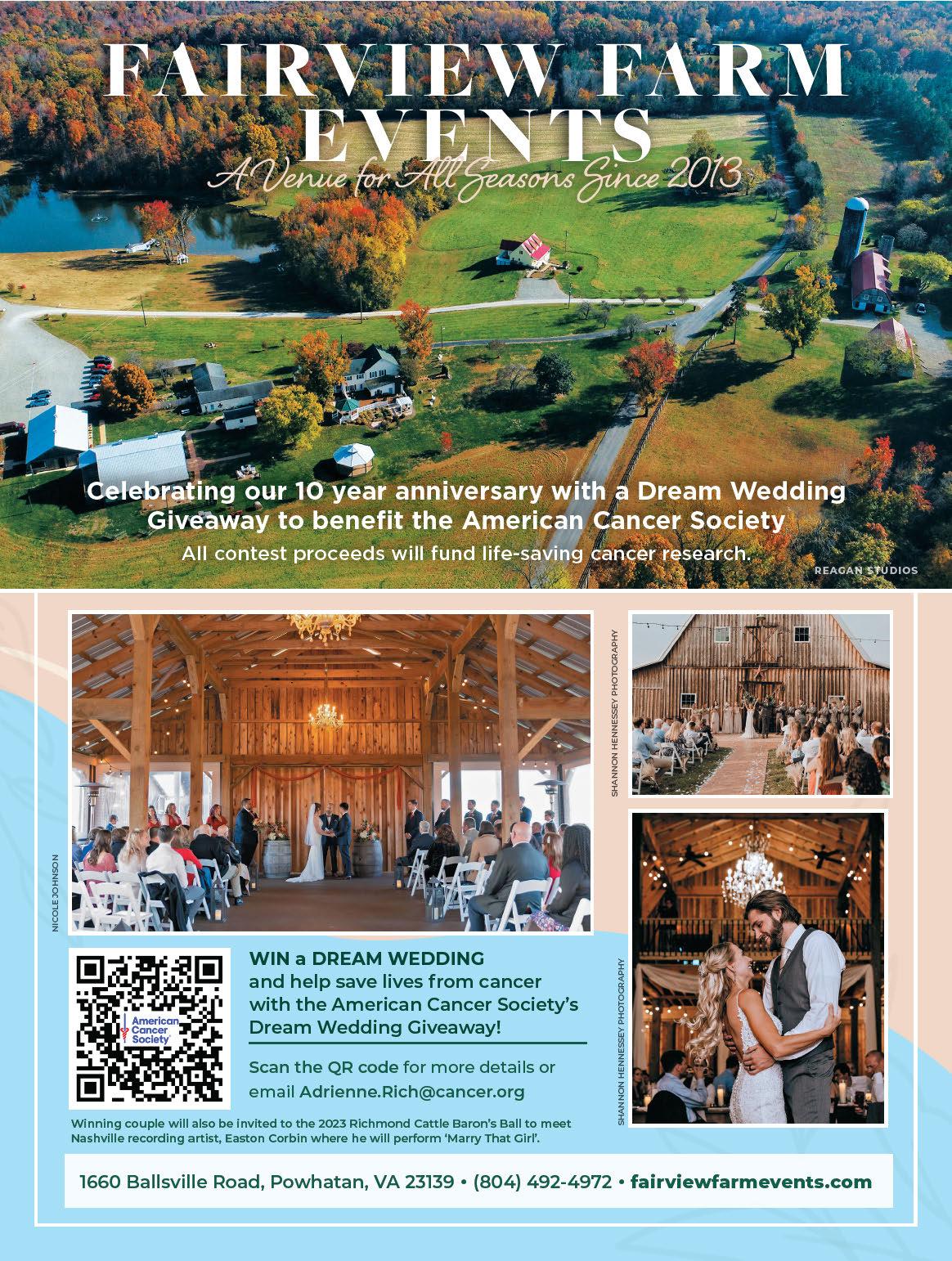







Few examples of the impact older adults can have on their communities stand out like the volunteer landscape.
Countless services provided through churches, nonprofits, schools, businesses and organizations are possible because of people o ering their time and e orts gratis. And while volunteerism isn’t limited to one age group, seniors do account for a significant part of the makeup of that unpaid workforce, says Alexa van Aartrijk, Chesterfield County’s Aging and Disability Services Manager.
e formal volunteering rate among baby boomers is 23.7%, dropping to 18% in the silent generation and older, according to AmeriCorps, which collaborates with the U.S. Census Bureau to collect data on volunteering and civic engagement every two years. However, the study doesn’t quantify the hours they contribute.
“We couldn’t function without seniors in the world of volunteerism,” van Aartrijk says. “If you walk into any volunteer landscape, you are going to see a lot of seniors in the room most of the time.”
Recognizing the role older residents
play in the community is the purpose behind the county’s Senior Volunteer Hall of Fame, which has been honoring dedicated volunteers since starting in 1982. Inductees through the years have ranged from ages 60 to 98.
This summer, three new inductees — Linda Hudgens, Alice Mitchell and A udrey Ross — were selected from a group of 20 nominees for the 2023 Hall of Fame class. Since turning 60, the 20 nominees cumulatively have donated more than 180,000 hours of community service, van Aartrijk says.

e three Chesterfield women volunteer in multiple ways. Hudgens started and serves as coordinator for the St. Ma hias’ Episcopal Church food pantry, which provides 6,000 meals a month. Mitchell is a pillar of the Aging and Disability Services Telephone Reassurance Program, which supports connectivity for older adults. Ross conducts research on the history of African Americans in Midlothian and provides presentations to the residents of the area.
It’s important to celebrate volunteers and show how vital their contributions are for the community, van Aartrijk says. R
HOUSING
Some seniors find it more attractive to stay in homes
A RECENT LOOK AT how long people are staying in their homes found that 39.4% of 65 and over households in Richmond moved in more than 30 years ago.
Using data from the Federal Reserve, researchers at U.S. Money Reserve, a company that sells precious metals and administers gold IRAs, found that baby boomer-owned real estate assets surpassed 40% of the U.S. total in the mid-1990s and have hovered between 40% and 50% since. Data from the Census Bureau shows that while Americans over age 65 represent just 17% of the population, they account for 32% of owner-occupied housing units.
Baby boomers may decide to stay in their homes because they like the house, their neighbors, the neighborhood and its proximity to familiar resources, says Laura Lafayette, CEO of the Richmond Association of Realtors. They don’t want to take on a mortgage again or feel they can afford another single-family detached home in today’s market, she says, “and if they need affordable housing options, especially apartments or progressive care facilities, we do not have enough of these units in metro Richmond.”
Looking at the region from 2013 to mid-2021, the share of starter homes sold has been in a steady decline. The greatest decrease has occurred in Chesterfield County, where the share of starter homes sold has gone from 63% to 46%, says Jovan Burton, executive director of Partnership for Housing Affordability in Richmond. The smallest decrease (8%) occurred in Henrico County.
It would help the overall health of the real estate market, and it would certainly help would-be first-time homebuyers, if more boomers decided to sell, Lafayette says. “But they have every right to age in place, if that is their choice.” —LM




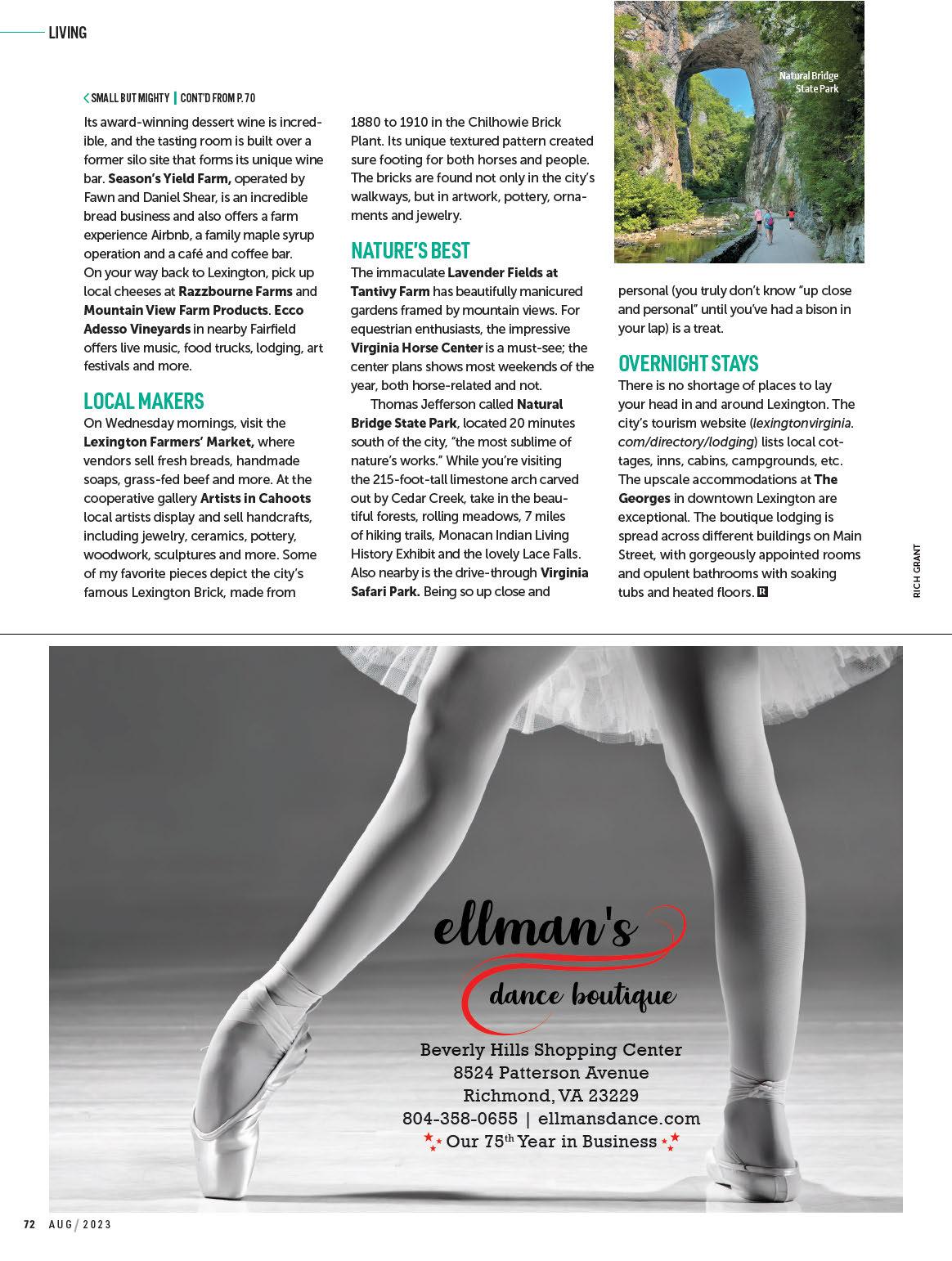




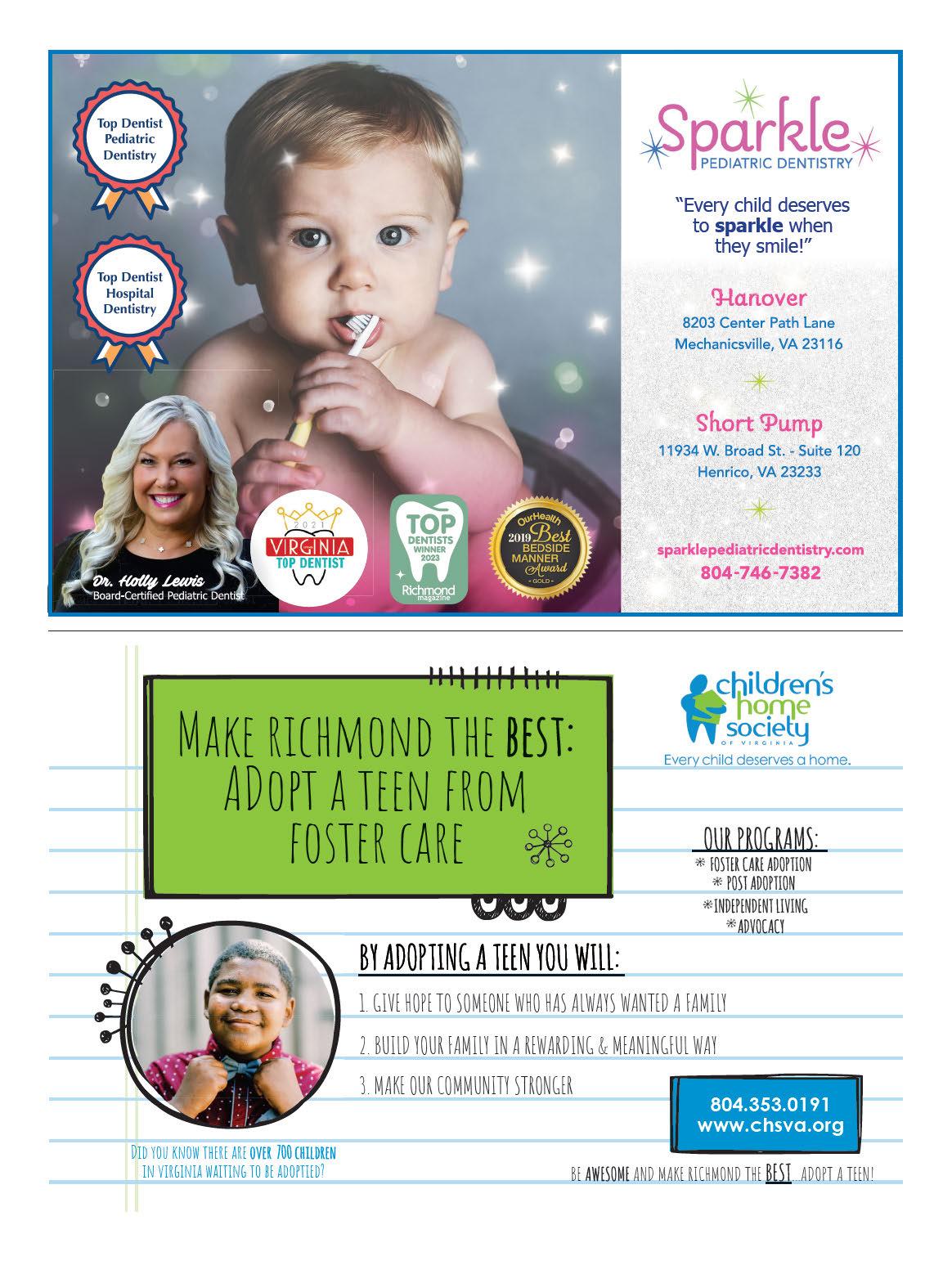

 Ash Hobson Carr of Hazel Witch Farm
Ash Hobson Carr of Hazel Witch Farm




Welcome to Richmond magazine’s 36th annual Best & Worst issue! Here we present readers’ picks across 200 categories: services, stores, restaurants, entertainment and many more. Unlike other “best” lists, we explore the ip side, too, by sharing Richmond’s less-than-stellar aspects, from tra c jams to political drama. Consider this compilation a user’s guide to the region, covering everything from where to shop, dine and get a haircut to where to go for a rst date (and where to nd someone to ask). Enjoy!
P. 86 News & Personalities
P. 92 Food & Drink
P. 112 Family & Community
P. 122 Recreation
P. 134 Shopping
P. 146 Services
Contributors: Ciara Brennan, Nicole Cohen, Bird Cox, Claire Fortier, Stephanie Ganz, Tharon Giddens, Mindy Kinsey, Harry Kollatz Jr., Mandy Loy, Laura McFarland, Eileen Mellon, Susan W. Morgan, Mark Newton, Emily Richardson, Genevelyn Steele and Will Thalhimer



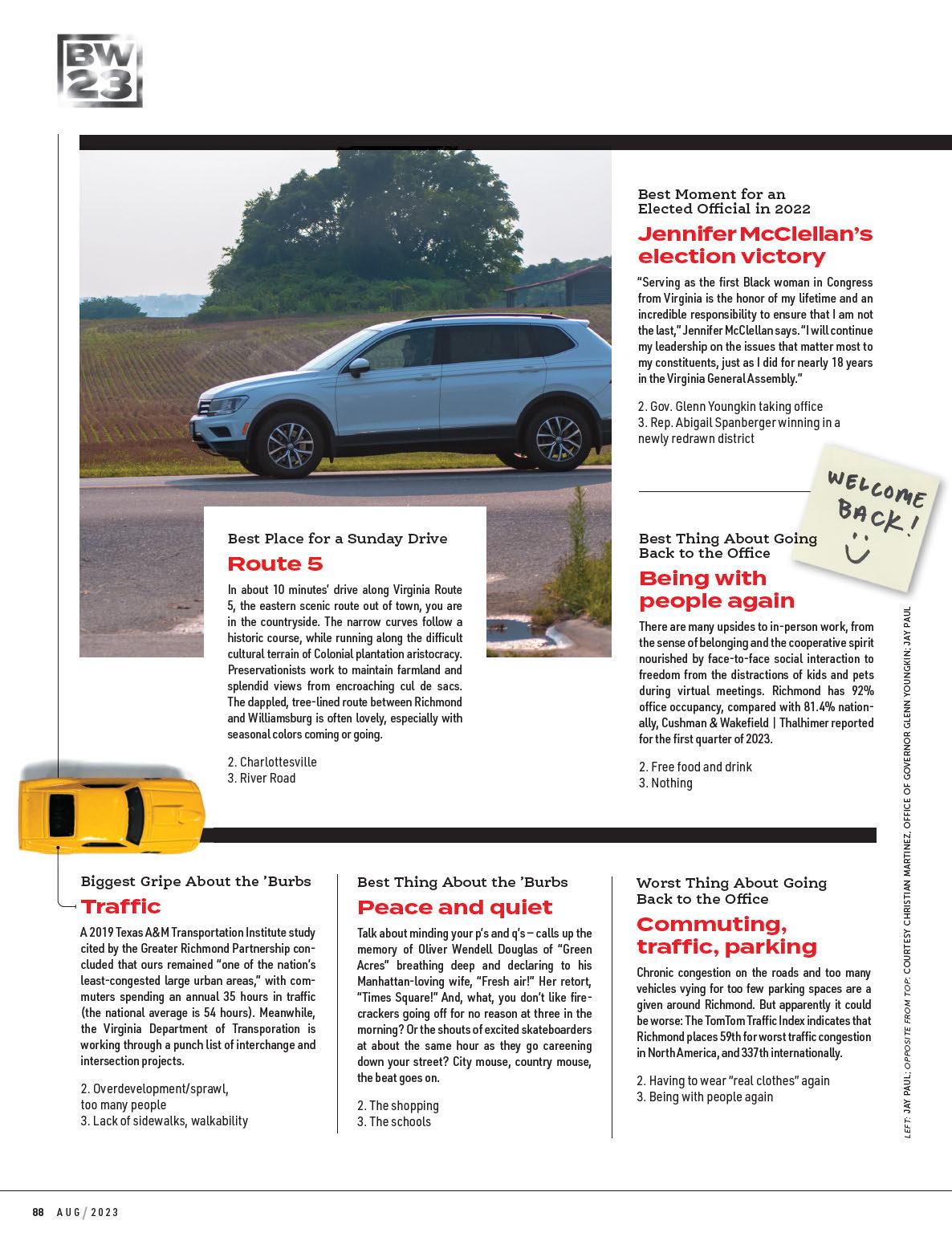




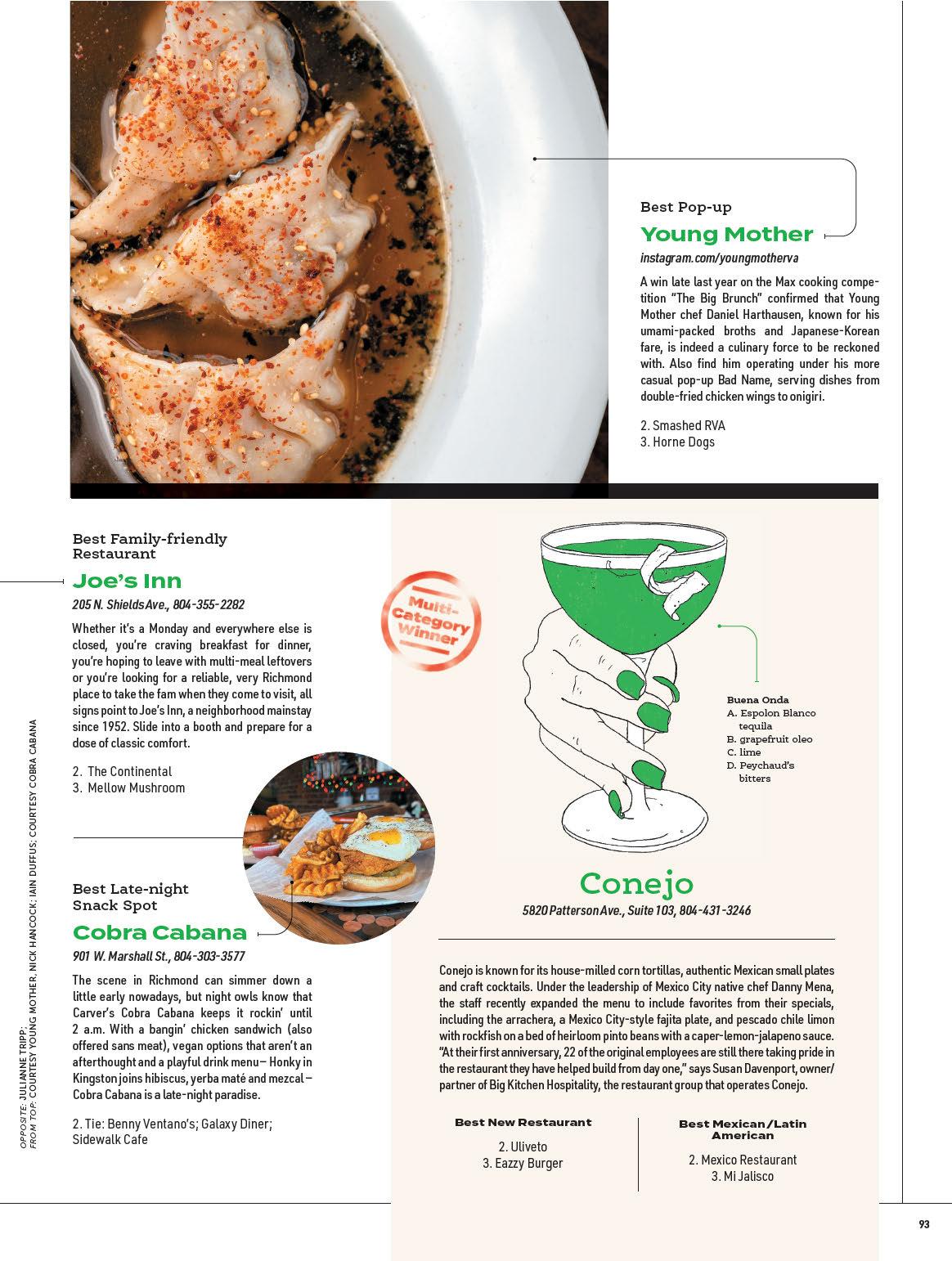
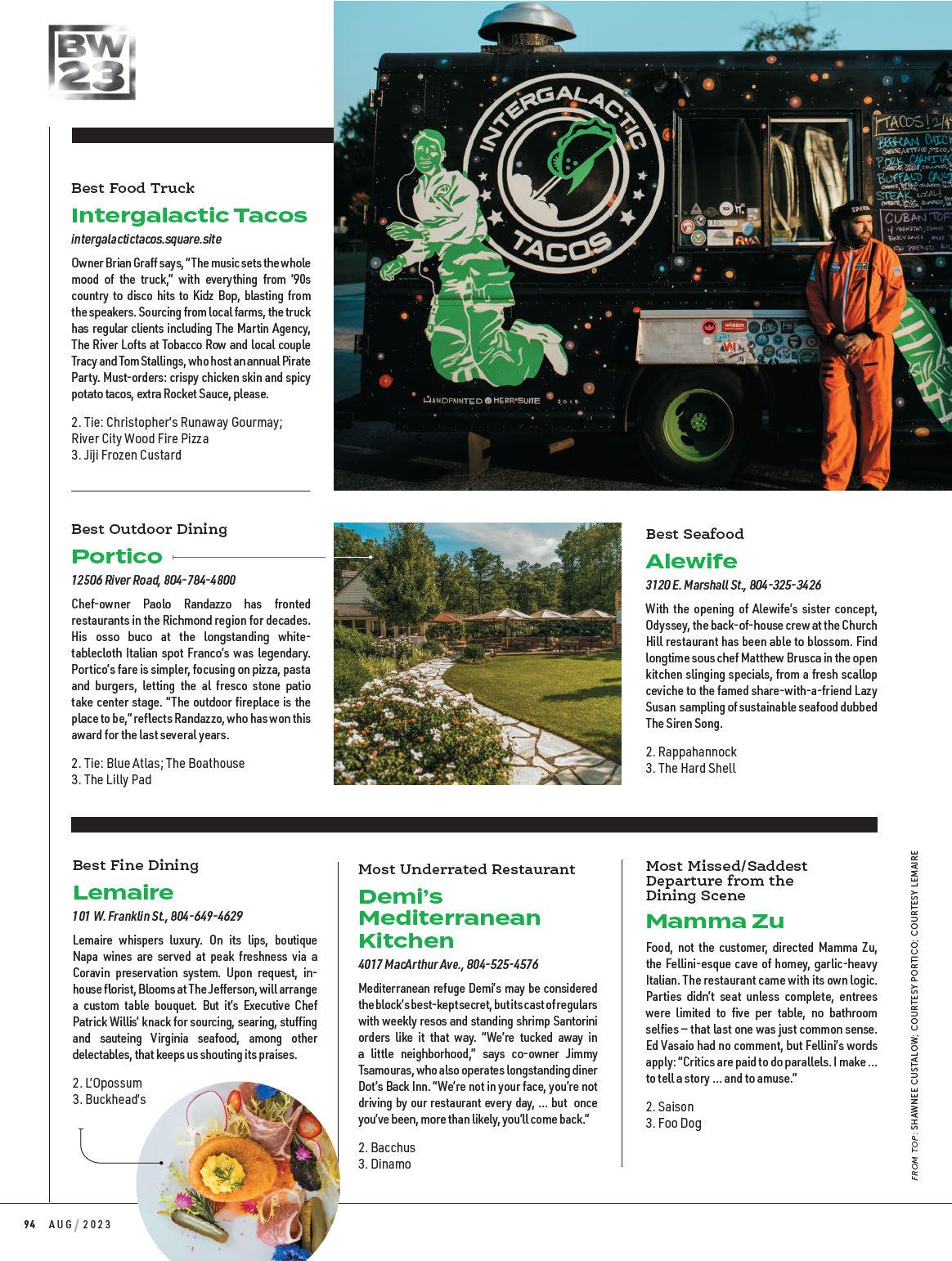
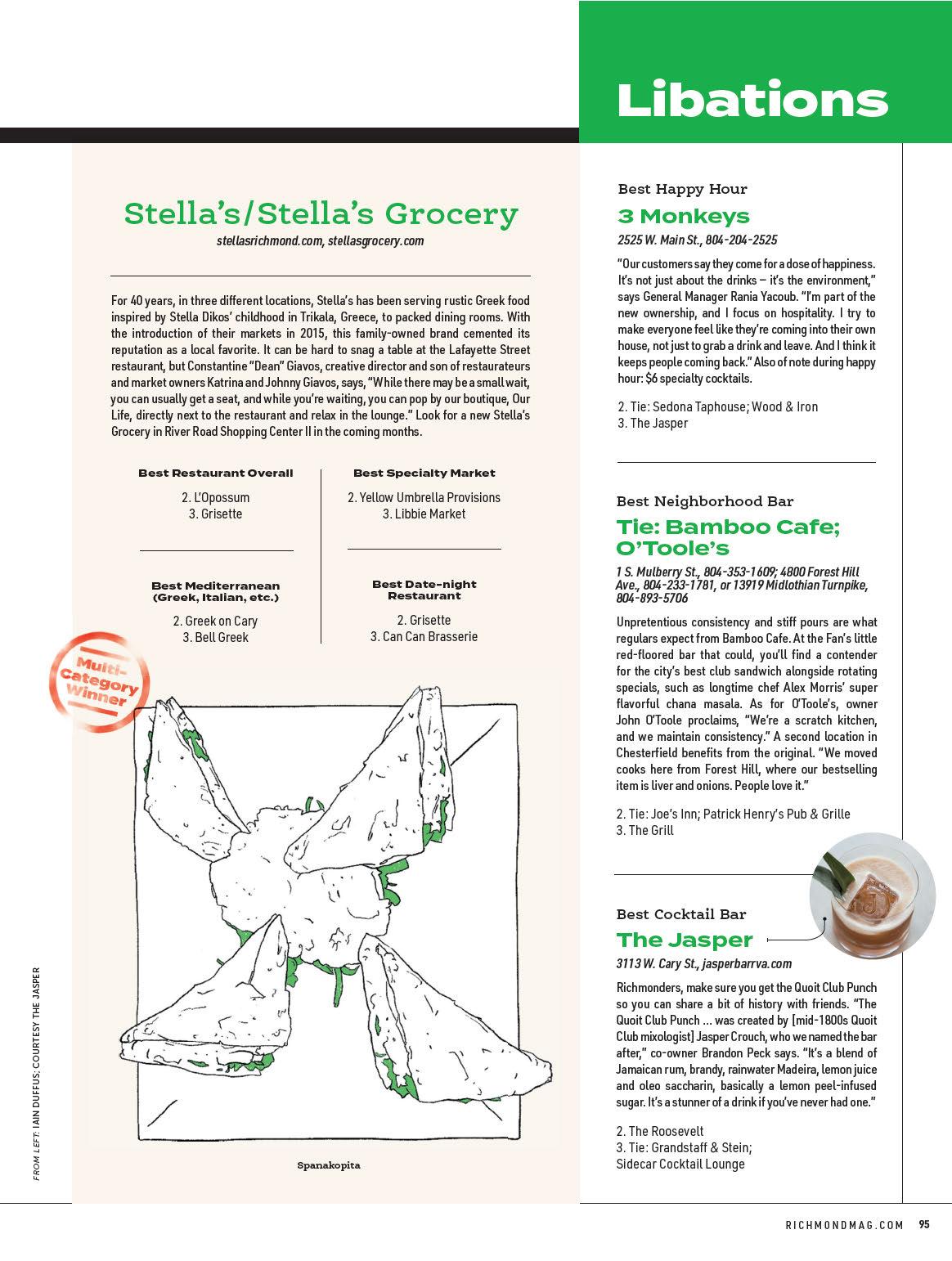



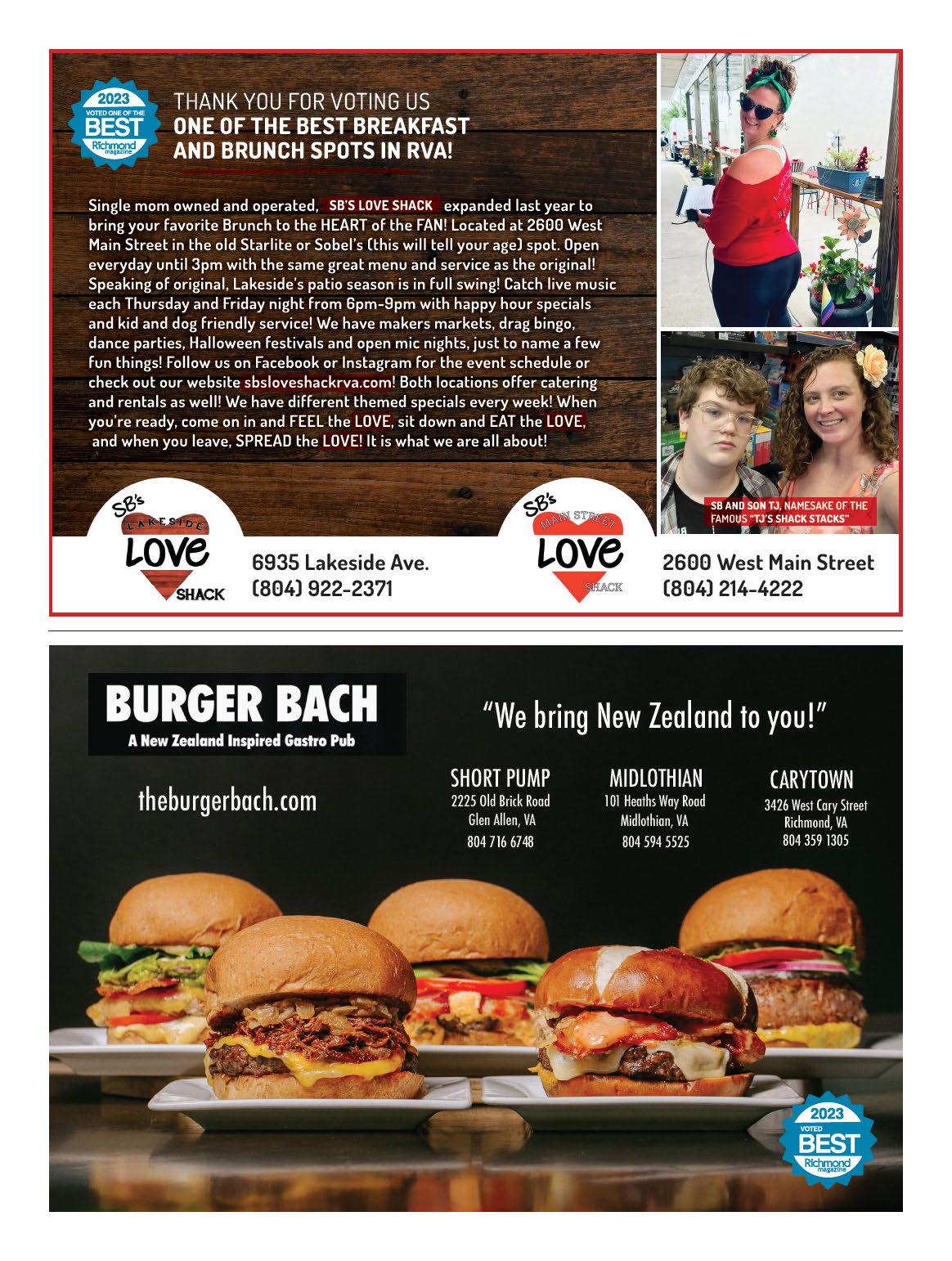






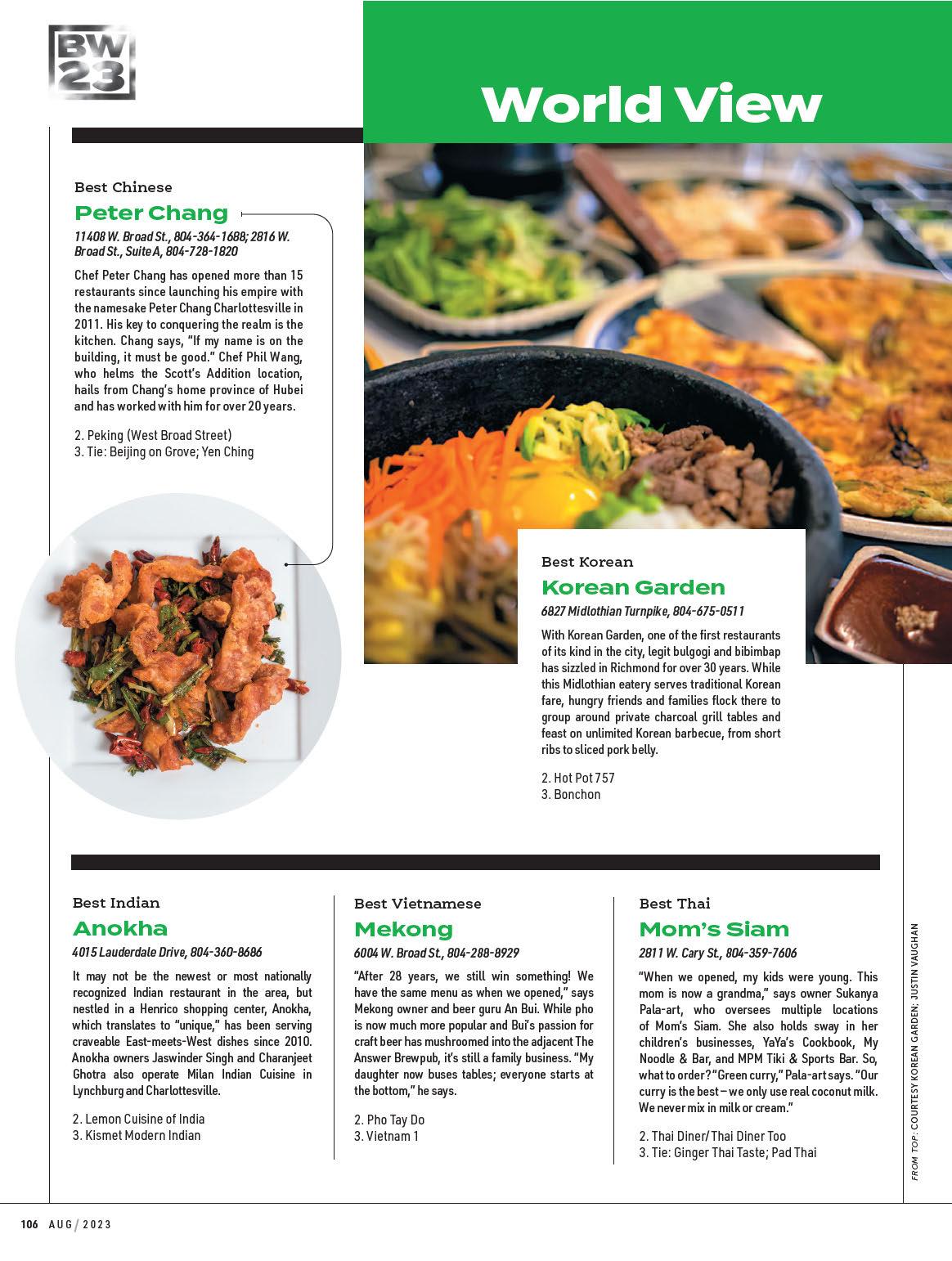

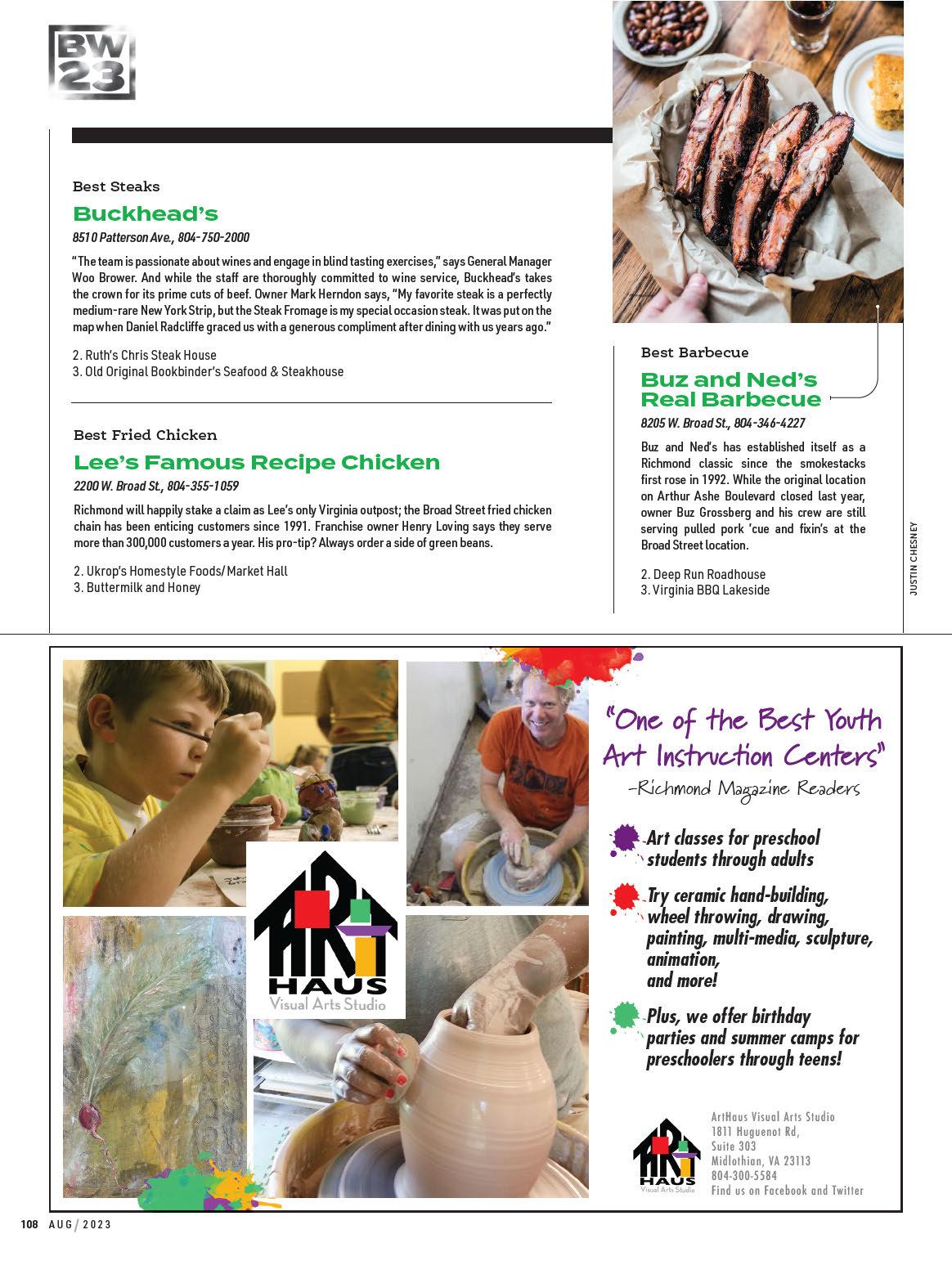





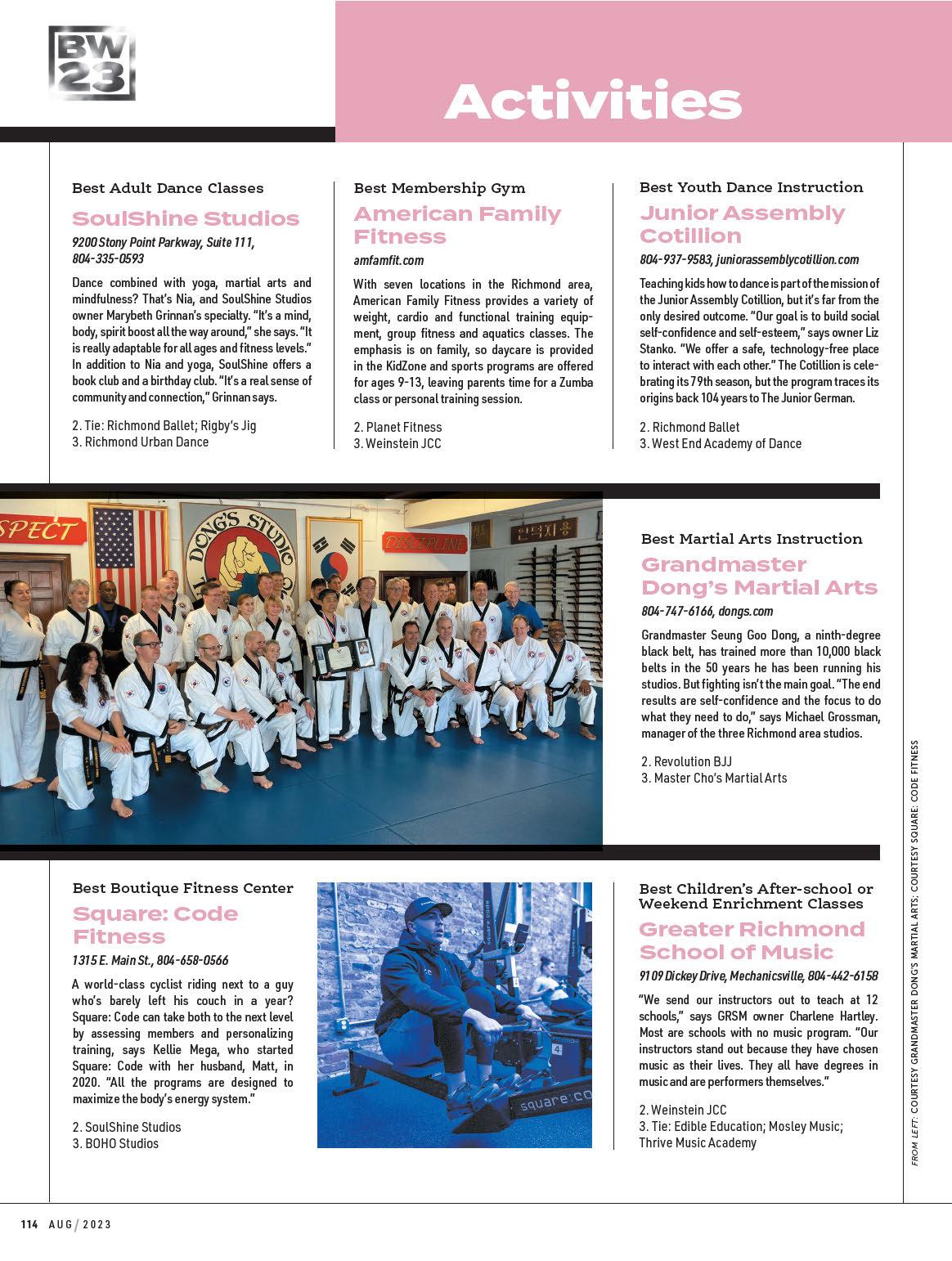

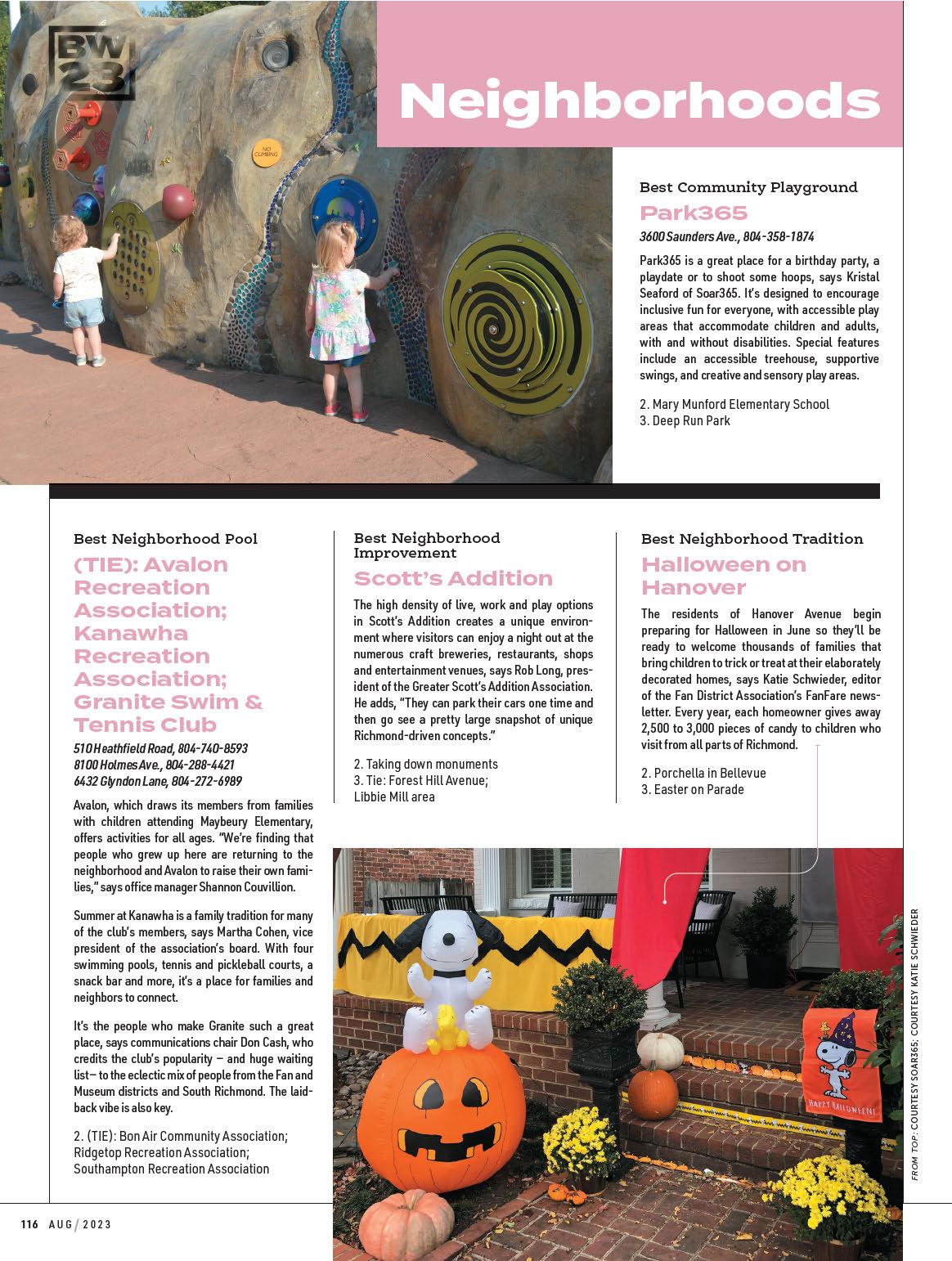

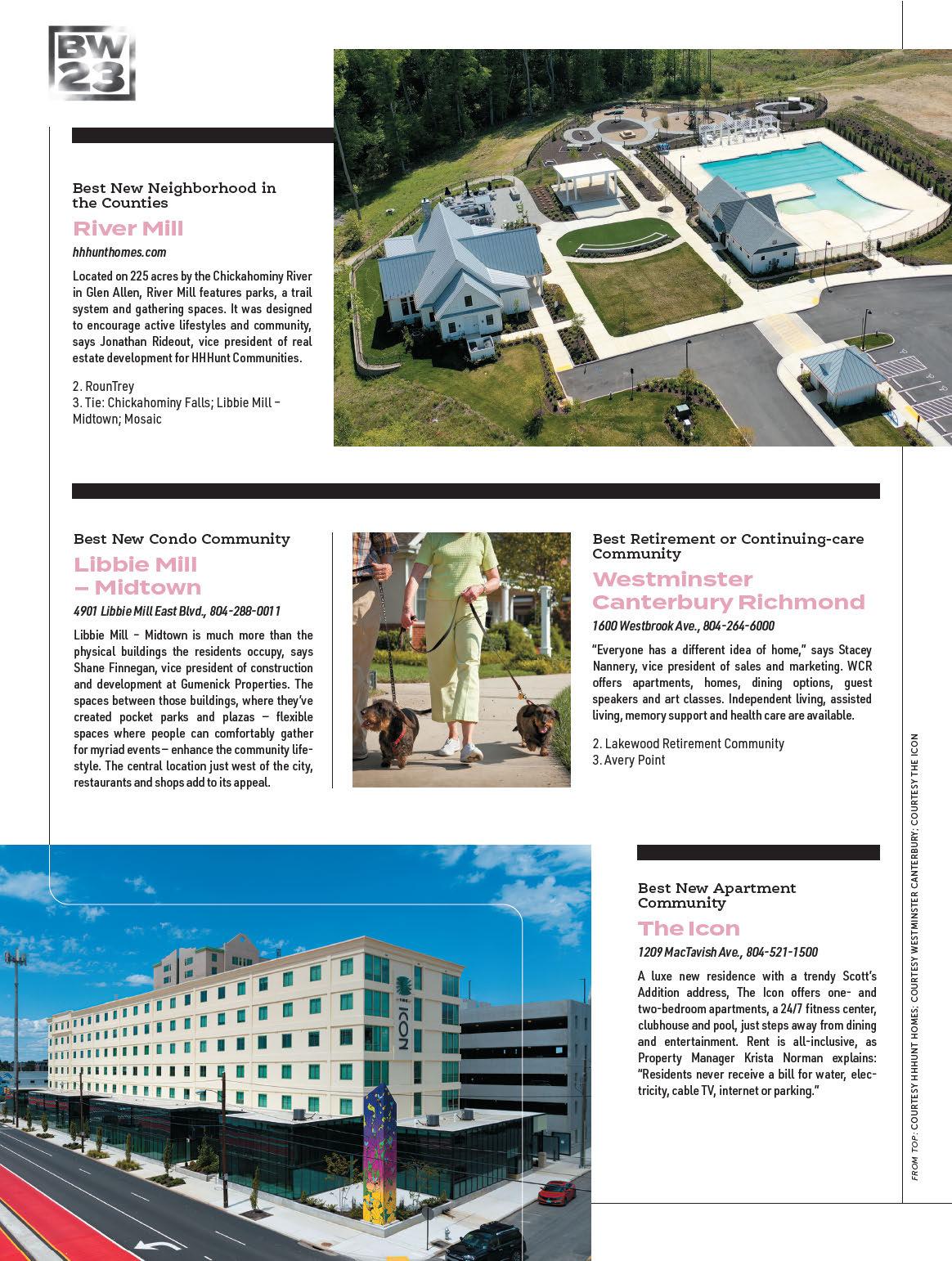








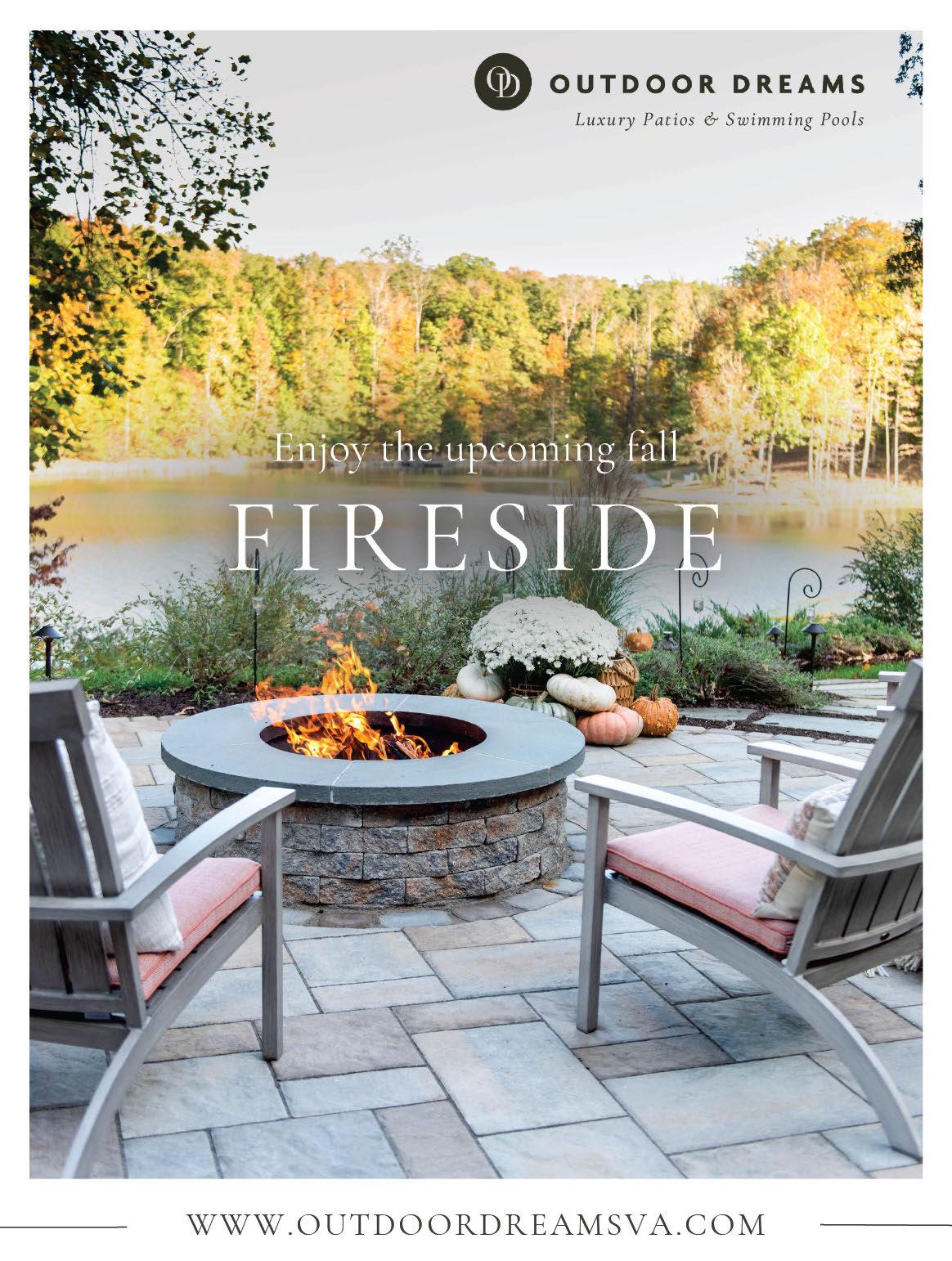














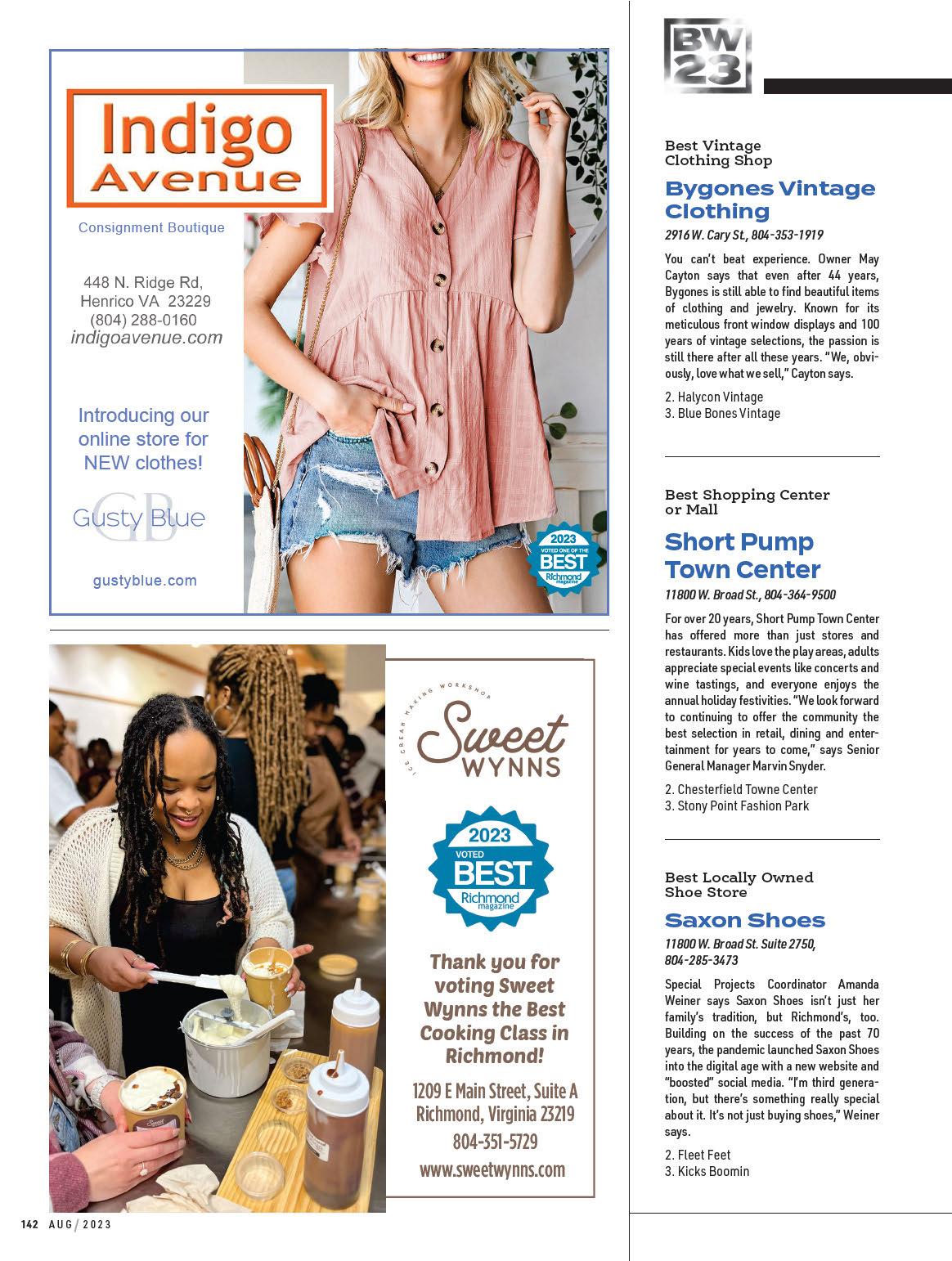







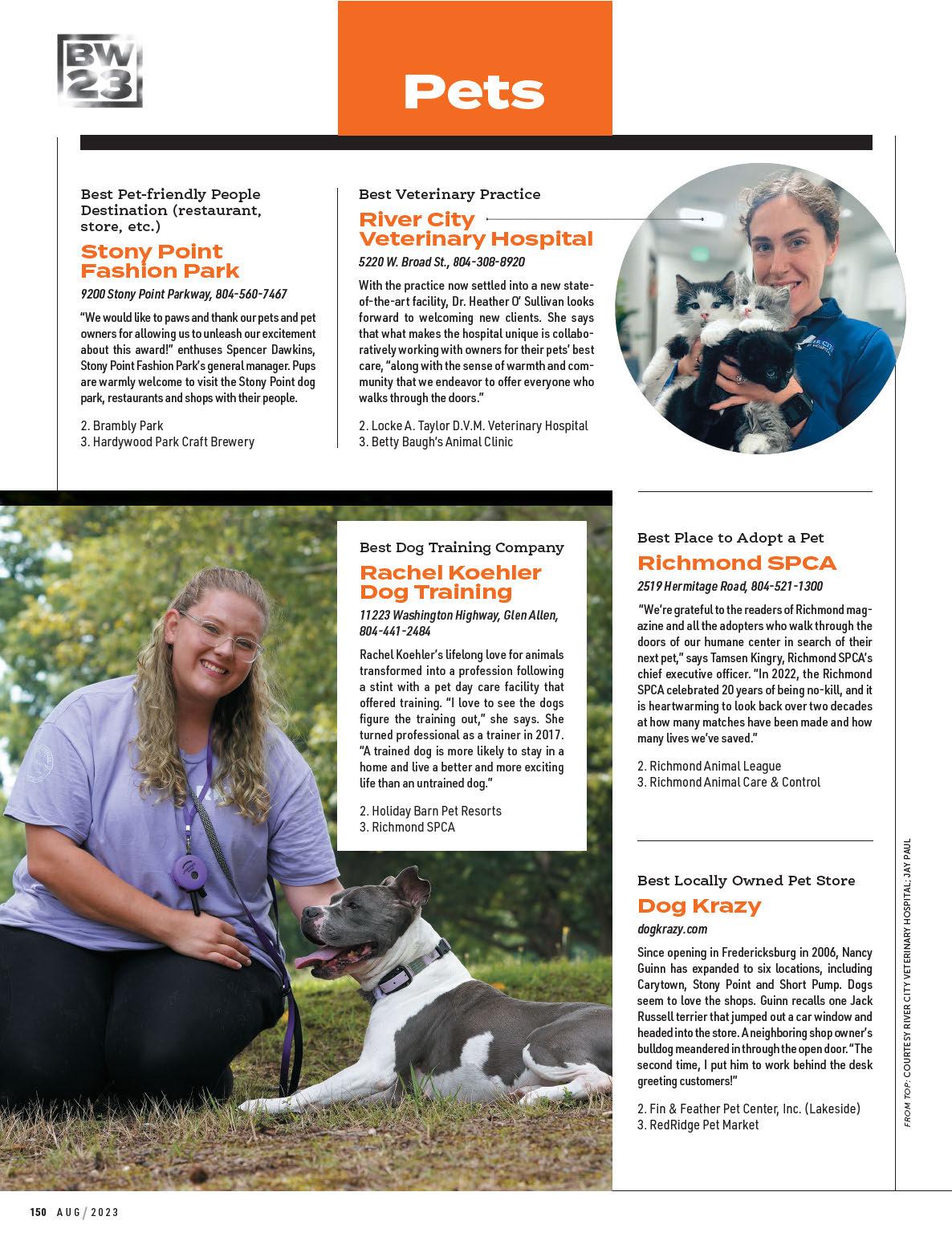
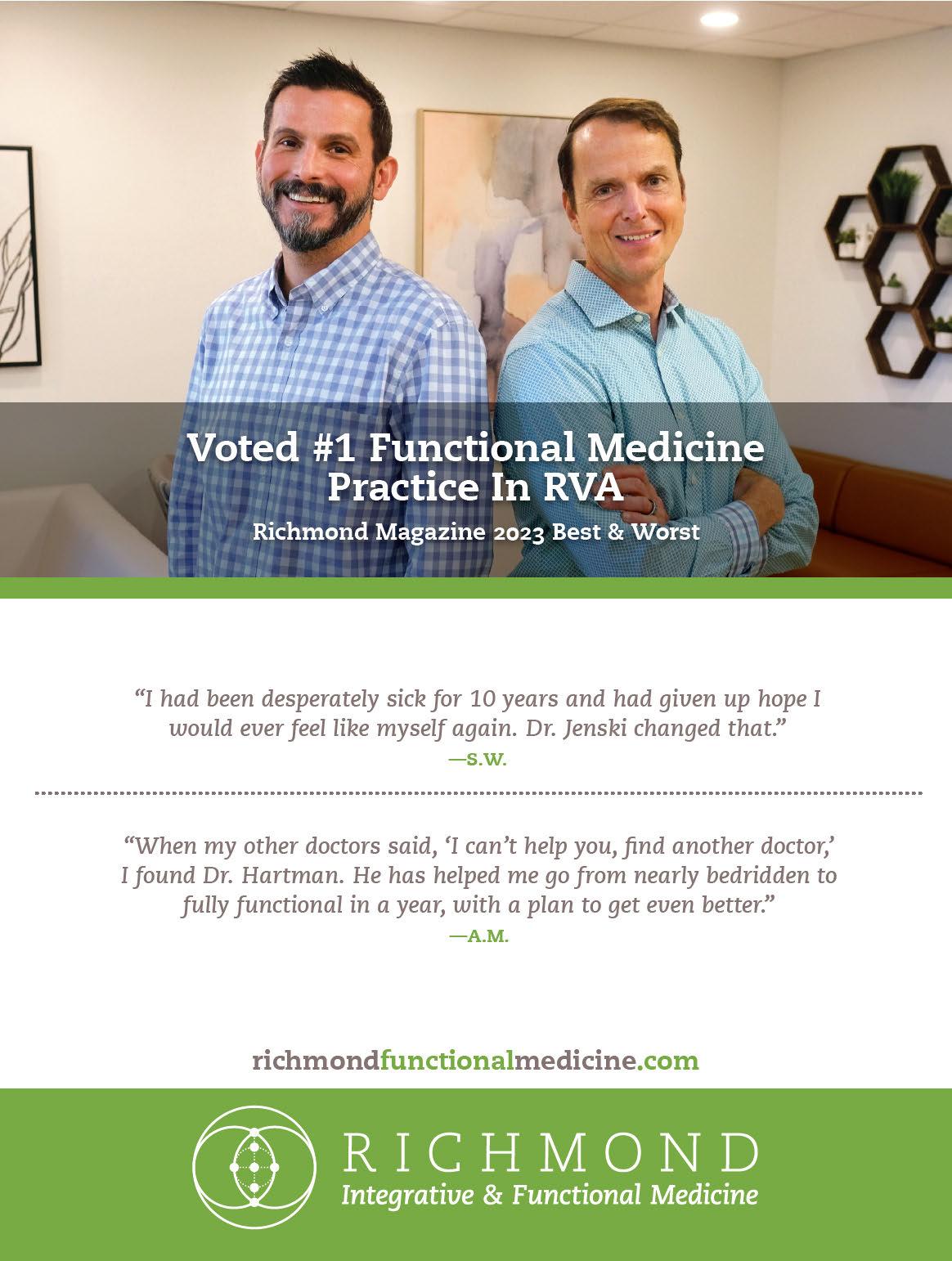


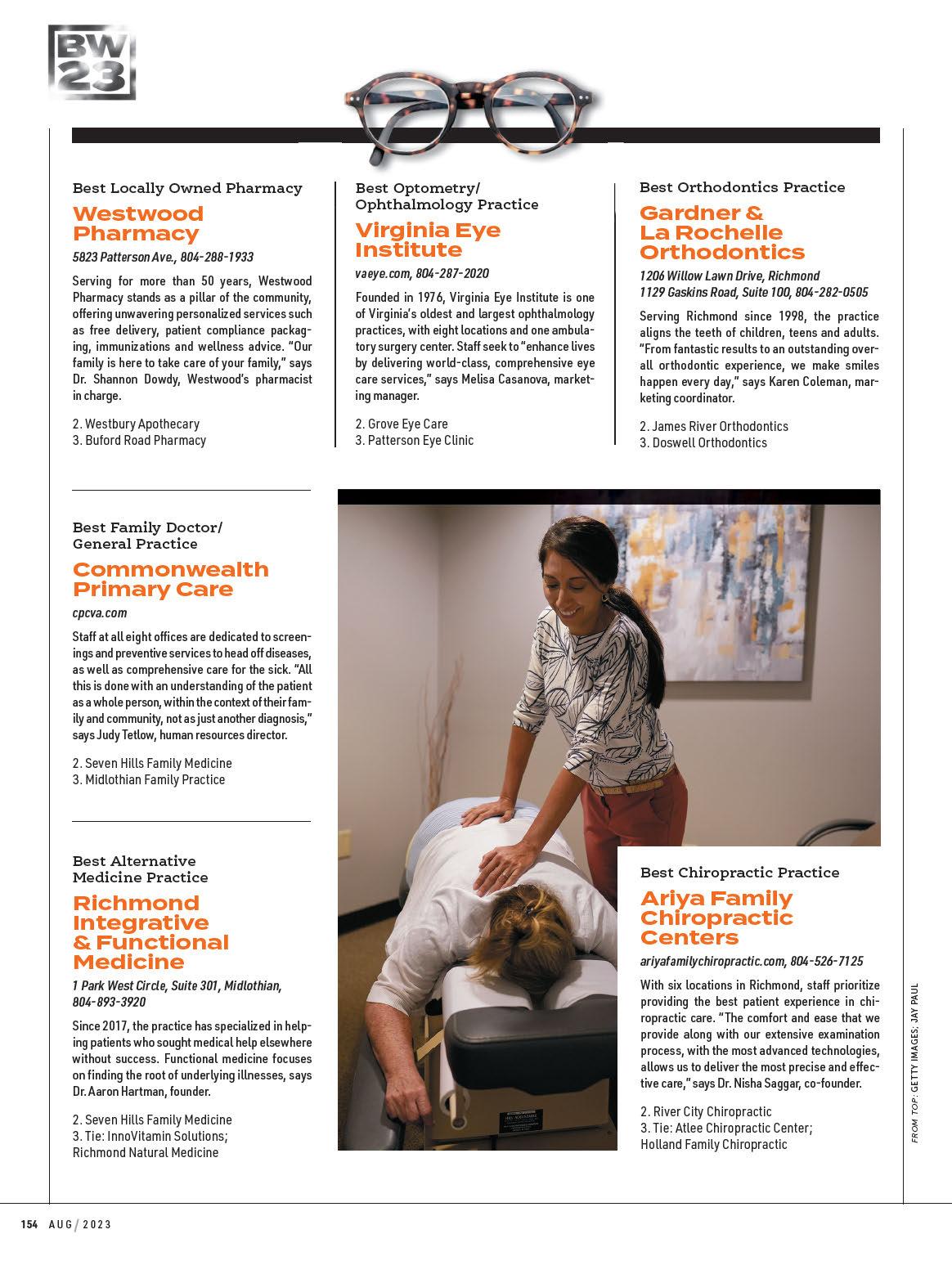


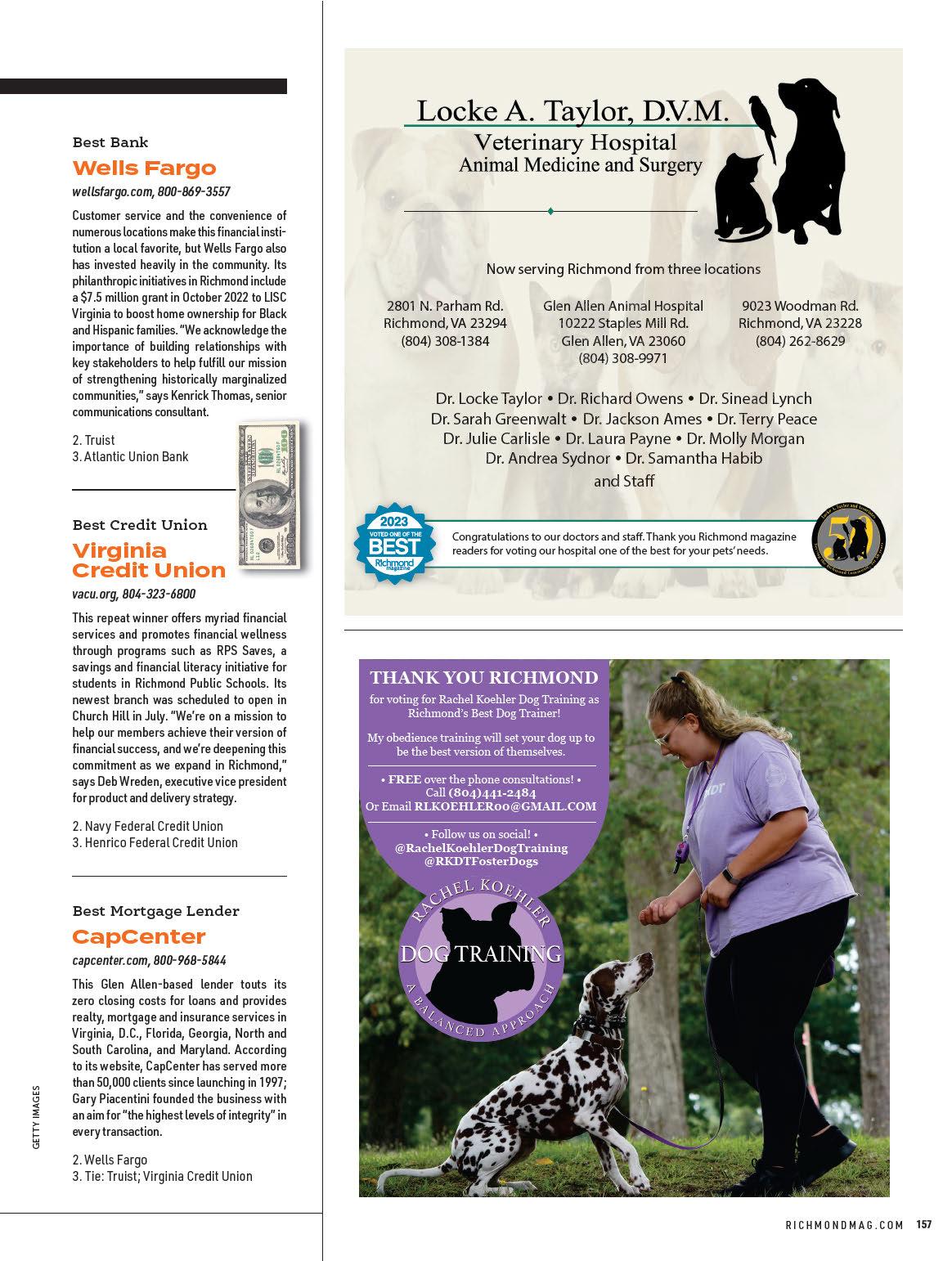










Two Richmond privateschool students will a end the University of Virginia this fall as Jefferson Scholars.

The merit-based scholarships that were awarded this year to 39 future Cavaliers provide full tuition, room and board for four years, as well as several enrichment programs sponsored by the Je erson Scholars Foundation.
Henry Bearden is also the winner of e Steward School’s highest honor, the Dixon Award, and Student-Athlete of the Year by the Virginia Sports Hall of Fame Foundation. He was captain of Steward’s varsity soccer team and the Richmond Kickers Elite team, and he has dedicated many volunteer hours to RVAccess, a program that o ers free athletic opportunities to those with special needs.
“Henry is relentlessly curious and accomplished: an intellectual, an athlete, a loyal friend and an excellent leader,”
says Head of School Dan Frank. “We look forward to seeing him flourish at UVA and beyond, just as he did during his years at Steward.”
Throughout her time in Collegiate School’s Upper School, Caroline Smith served as class president and was on the honor roll. She has been recognized as a fiction writer and poet, and she has researched algae and red tide pollution, as well as the impact of climate change on marine ecosystems and oyster populations. She served as president of RVAccess for three years and Oak GroveBellemeade Saturday Literacy Academy
for one year. Smith was also captain of Collegiate’s championship-winning varsity tennis team.
According to Jimmy Wright, president of the Je erson Scholars Foundation, one Richmond-area public school student was named a Je erson Scholar: Ishita Bakshi of Douglas S. Freeman High School. In addition, Blanly Teresa Rodriguez of Monacan High School is one of 17 recipients of the foundation’s Walentas Scholarship, which supports students who would be in the first generation of their families to earn a bachelor’s degree. —MN
AFTER A TWO-YEAR nationwide search, Collegiate School has a new, permanent head of school. Jeff Mancabelli is replacing the interim head of school, Wiliam “Billy” S. Peebles IV, who assumed the role in August 2022. He starts on July 1, 2024.

Mancabelli, unanimously approved by Collegiate’s Board of Trustees in May, currently serves as president of St. John’s College High School, a Catholic school in Washington, D.C. With more than three decades of experience in education, Mancabelli’s success comes from a combination of “prioritizing student success and fostering a thriving
school culture and community,” Carter Reid, chair of Collegiate’s Board of Trustees, said in a statement, which added that Collegiate’s board believes that Mancabelli’s skills and values align “seamlessly with Collegiate’s core values and aspirations.”

Under Mancabelli, St. John’s College High School increased enrollment by 24% and doubled its endowment, according to a press release.
Mancabelli said in a statement that his visit to Collegiate School was inspiring thanks to the “faculty and staff’s commitment to a challenging and supportive educational experience where
each student is known as an individual.” He added that he truly cares about providing personal attention and instilling a sense of family, which are staples in Collegiate School’s mission.
“Jeff embodies all of the characteristics we were searching for,” says Brandt Surgner, vice chair of the Board of Trustees, adding that he is a “seasoned independent school leader who puts students first” and has an extensive understanding of Collegiate’s master and strategic plans. “The Board of Trustees has full faith in Mancabelli,” Surgner says. “His experience and thoughtfulness will surely aid the smooth transition from interim to head of school in the coming year.” Will Thalhimer

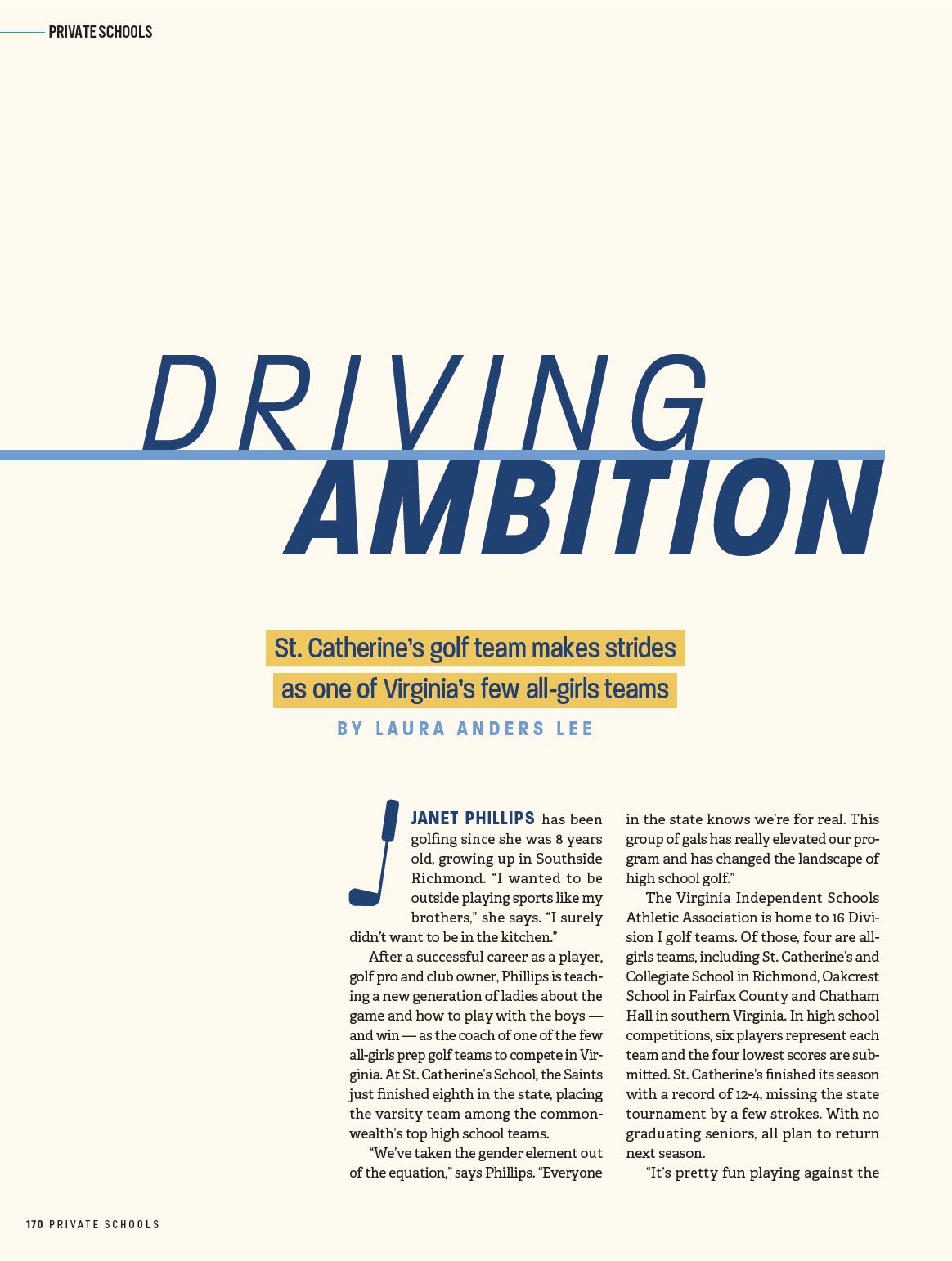
boys teams,” says varsity player Grace Anne Haggerty. “We don’t really care who we’re playing as long as it’s good competition.”
Because golfers may tee o from six starting points, players of all levels can compete equitably on the fairway. On a typical course, professional male golfers play o the black tees while more experienced men start from the middle white and blue tees. Women drive from the red tees, while seniors play yellow and youth play green, which is closest to the hole.
“We set up tees 15% less than where the guys tee o , and our goal is to have similar clubs hi ing into the greens,” says Phillips. “We’re not going to compete in a long drive contest against some of the be er guys, but we can be more accurate and hit right
in the fairway. We also work on our short game. Our forte is putting and chipping.”
Saints player Eliza Hershey says she was a li le nervous at first, but that quickly changed with a pep talk from Phillips. “Coach Janet took me aside and said, ‘You deserve to be here — you earned this spot,’ and that completely changed my mindset,” she recalls. Hershey says winning is gratifying when the boys underestimate them. “ ey’ll think it’s going to be an easy win, and we come out and beat them.”
e nine varsity players say they are grateful to have Phillips as their coach and mentor. “We’re lucky to have a coach
who’s actually a golf pro,” says Saints golfer Adelaide Goolsby. “And because she’s very involved with the LPGA, she understands the rules, answers our questions, helps with our golf swing and is very encouraging,” adds player Emma Dixon.
A er graduating from Monacan High School in 1984, Phillips played golf for James Madison University, then professionally for three years. She later moved back home, where she co-owned and ran Windy Hill Golf Course for 32 years. She also started the women’s golf program at the University of Richmond as well as Richmond’s first Special Olympics for golf. In 2006, she was awarded the PGA President’s Award, and the following year,


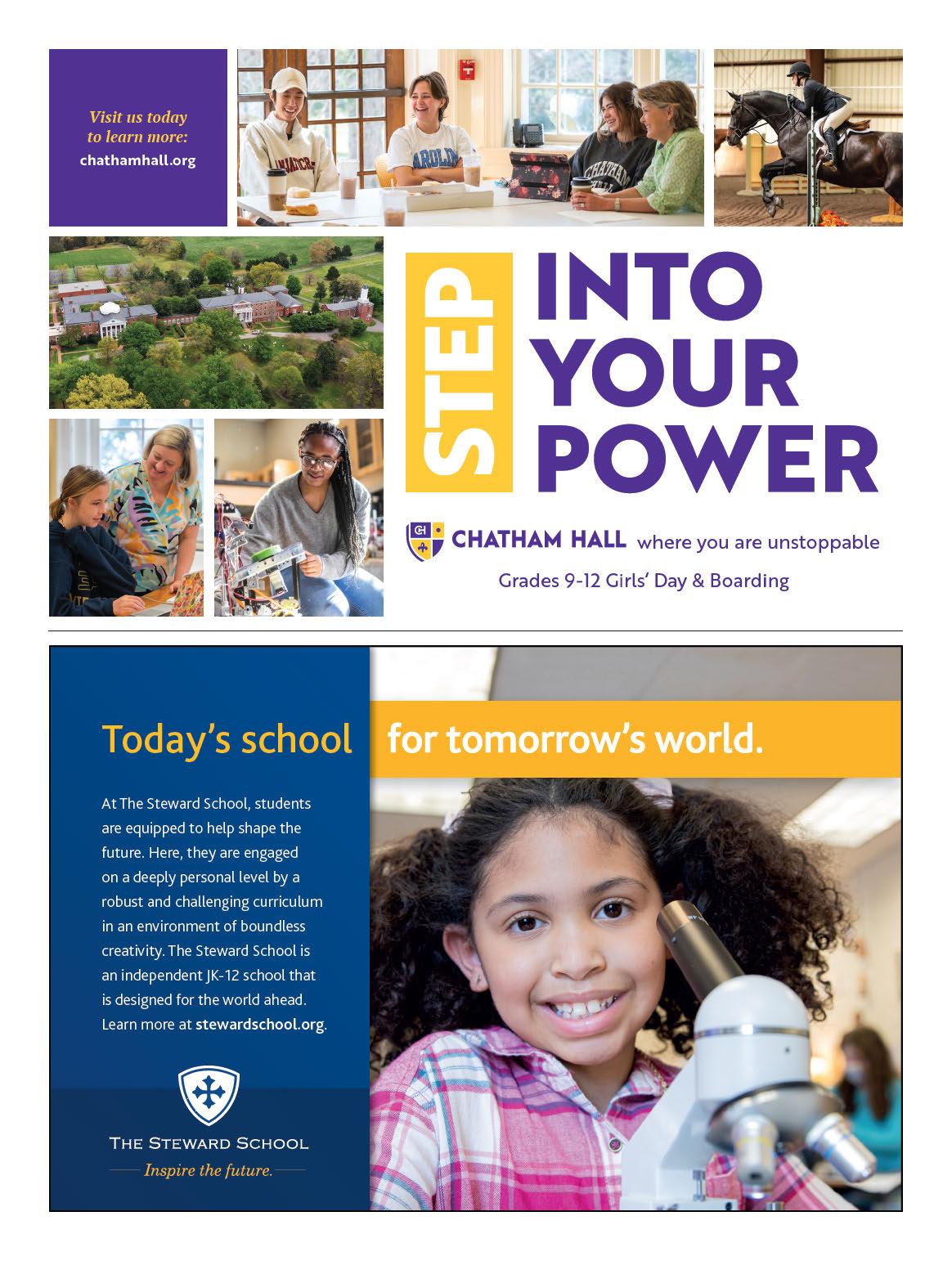


overwhelmed by the range of private school options available in metro Richmond, parents should feel optimistic that they can find a good fit for their child and family.
“Pretend you’re being investigators,” says Rachel Gladstone, an educational consultant with Westhampton Family Psychologists in Tuckahoe. “Try to see all the choices and options, and remember nothing is wri en in stone.”
Gladstone says it’s common for parents who a ended private schools themselves to seek a similar experience for their children. Other parents believe a private school would suit their child’s
needs better than than their assigned public school. It’s also possible that as a child progresses through their education, a di erent school se ing might be more appropriate. “ ere’s so much variability, with so many di erent people with di erent needs and circumstances,” Gladstone notes. “It truly is so individual, which is why careful consideration and a ention need to go into school choice.”
Courtney Rosenthal began evaluating private schools for her first child in summer 2021, with an anticipated enrollment in kindergarten in the 2023-24 school year. Rosenthal a ended private school for grades K-6 and then finished in public
schools; her husband, Matt, attended public schools for his K-12 education. eir motivation to seek a private option for their daughter stemmed from a desire to find a place that would nurture her love of the arts. “Her life is a musical,” Rosenthal says. “She’s always singing.”

The Rosenthals set parameters on their search: K-12 programming and coed instruction with no religious a liation.
“That really narrowed the scope,” Courtney Rosenthal says. She and her husband assembled a list of questions and sent it to admissions directors at their top two choices. “ at set a framework for the discussions we had with admissions and leadership with both of the schools,” she says. “As my husband and I sat down
and discussed where we wanted to apply, we had answers.”
e family secured a seat for their daughter in the school of their choice — but in a junior kindergarten, or JK, classroom last fall, a full year earlier than they planned. “I realized that for many independent schools in Richmond, the admissions process really is for the JK year,” Rosenthal says. “ en there are only a handful of slots for kindergarten. We realized the numbers weren’t good if we waited, because there wouldn’t be many slots available.”
Margaret and Adam Preston had two children enrolled in their neighborhood public school when the COVID-19 pandemic began in spring 2020 — a daughter in second grade and a son in kindergarten. ey had been considering moving their daughter to a private school, so they were ready to make the leap to virtual learning o ered by the school they preferred.
“That was the time to set a good foundation in terms of learning and excitement for learning,” Margaret Preston says. “We wanted more challenge and customized work, and we felt we had done the process as best we could in [our] public school. You can’t fault anyone there, but they have the square they have to teach to. e anomalies, at both ends, are harder to pay a ention to.”
e couple’s process included gathering recommendations from friends and “being a li le old school. Write it all down and see where you are: priorities, nonnegotiables, what do they have [to o er],” she says. “A mom has an intuition as to what her kids need.”
en they took general admissions tours. ey paid a ention to the academic “extras” not available at their public school and observed smaller class sizes. At the end of one tour, as Margaret Preston was asking questions, the admissions director suggested the couple meet with the head of school. “We felt like we were their priority, even with a slew of folks in the admissions process,” she says. “We asked specific questions to see if they could fill in the gaps we were experiencing.”
Initially, the Prestons planned to enroll only their oldest child, but all three of their children are now at the same school. “We loved [the school], loved the community,” she says. “Once we got over there and realized the breadth of ‘specials’ and extracurriculars, we thought, ‘Why wouldn’t we do this for the boys?’”
Educational consultant Lindsey Melvin says the pandemic motivated some parents to move their children from public to private se ings. “ e demand [for private schools] was much greater than I’ve seen in a long time,” she says. “I’m curious to see [where we are now], but from 2020 into 2022, there was an absolute increase in interest in private schools.”
Melvin advises parents to research schools’ mission, size, costs and learning styles. She also encourages parents to go deeper. “I want them to do some soul-searching before they start looking,” she says. “ ey need to think about their own personal and educational values. Is it important for a school to incorporate the arts, time outdoors or religious faith or follow a certain educational approach, like [international baccalaureate] or classical? Sometimes, families don’t know.”
Most private schools require educational assessments, either administered by private psychologists or the schools themselves. A child may want an explanation about why that’s necessary. e child’s age also a ects the role they will play.
“With every year, it becomes increasingly important to involve them in discussion and dialogue,” Melvin says. “How do you know it’s going to be the right community? Explore all the ways the school o ers you to know that information: parent tours, shadow days, talking with parents of enrolled students. Is [the school] really what it sounds like?”
Even a er a family finds a school that fits their child’s needs, Melvin notes parents need to pay a ention, as circumstances
“[PARENTS] NEED TO THINK ABOUT THEIR OWN PERSONAL AND EDUCATIONAL VALUES ... SOMETIMES, FAMILIES DON’T KNOW.”
—Lindsey Melvin, educational consultant


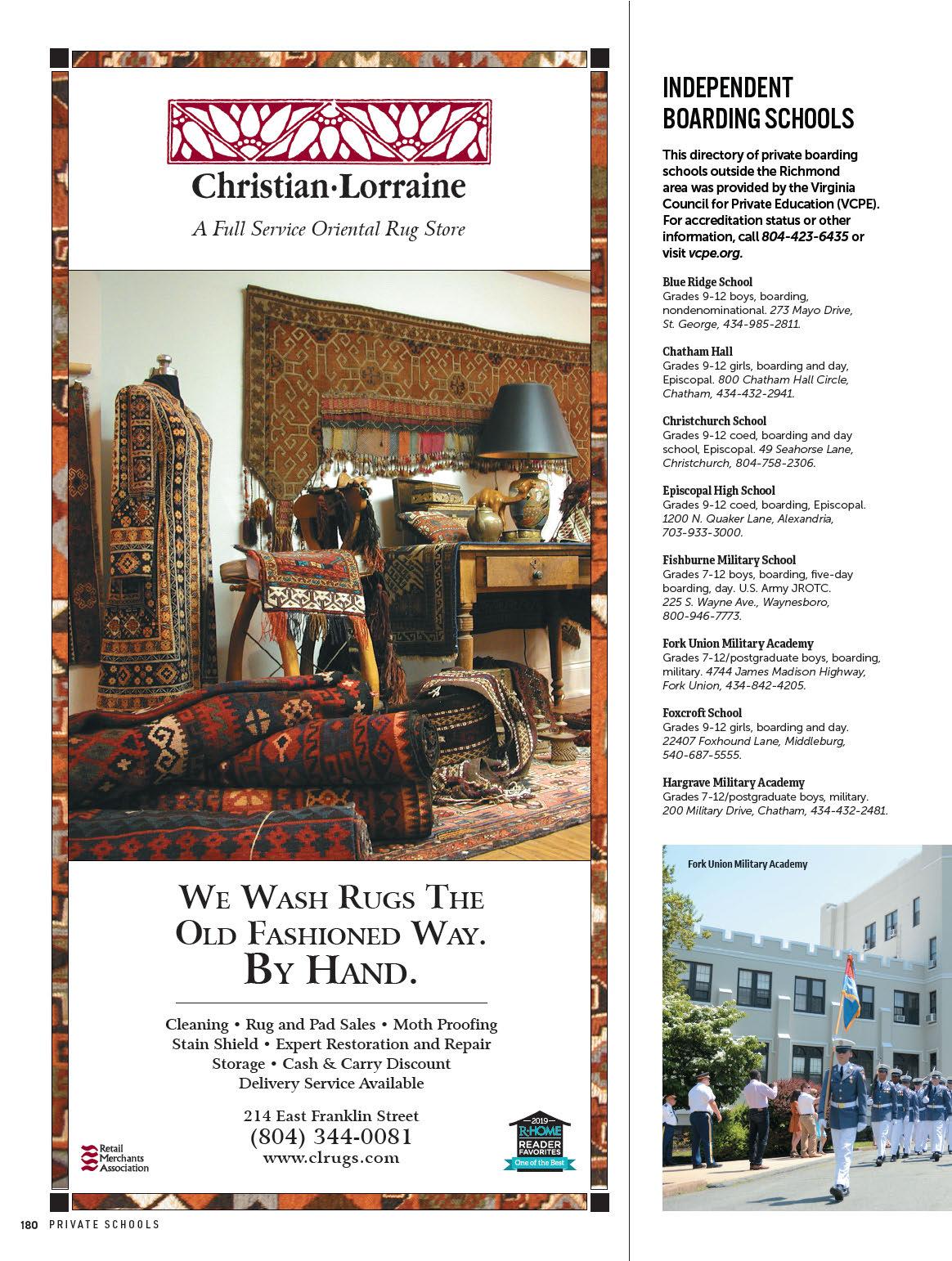

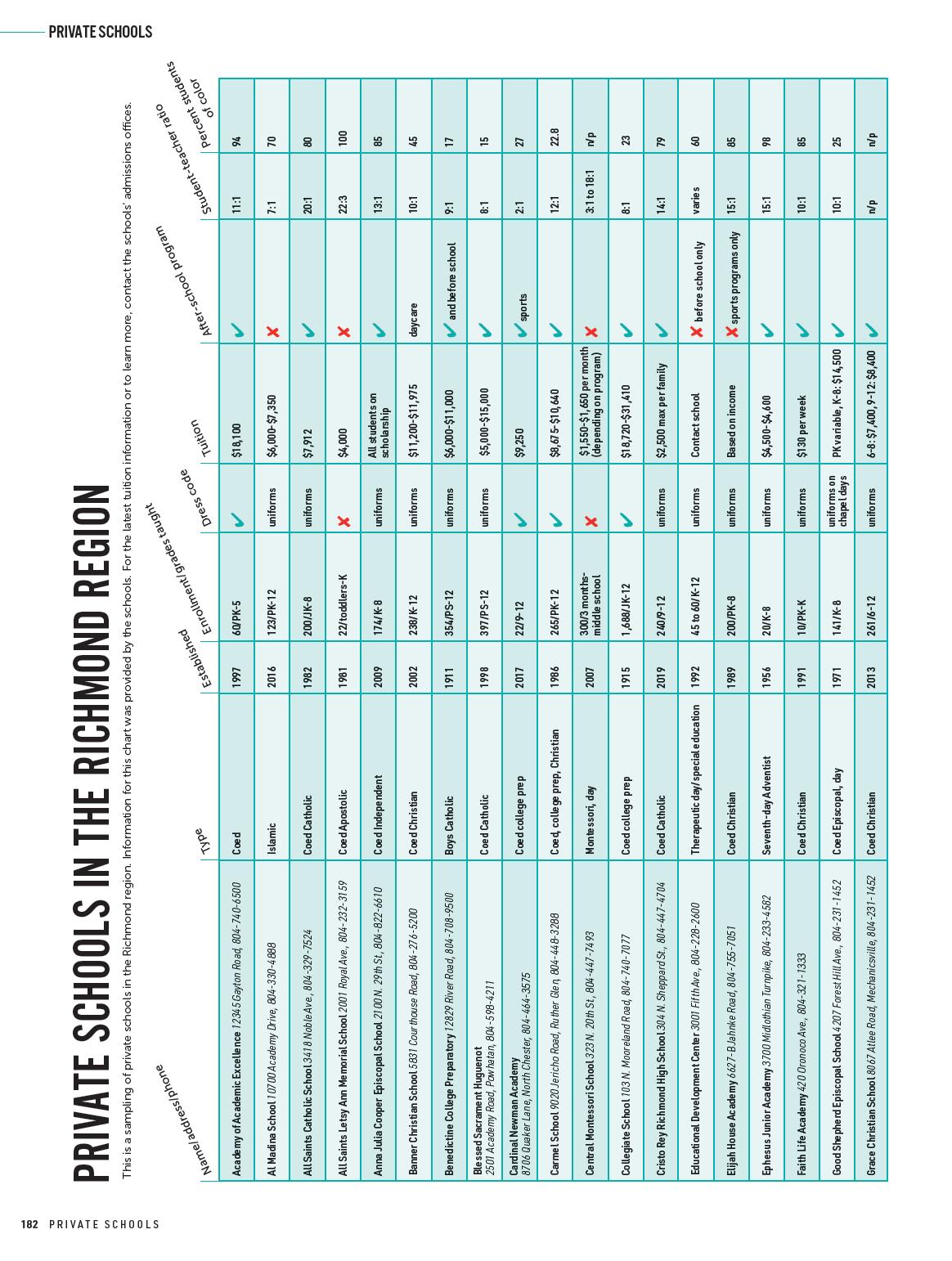
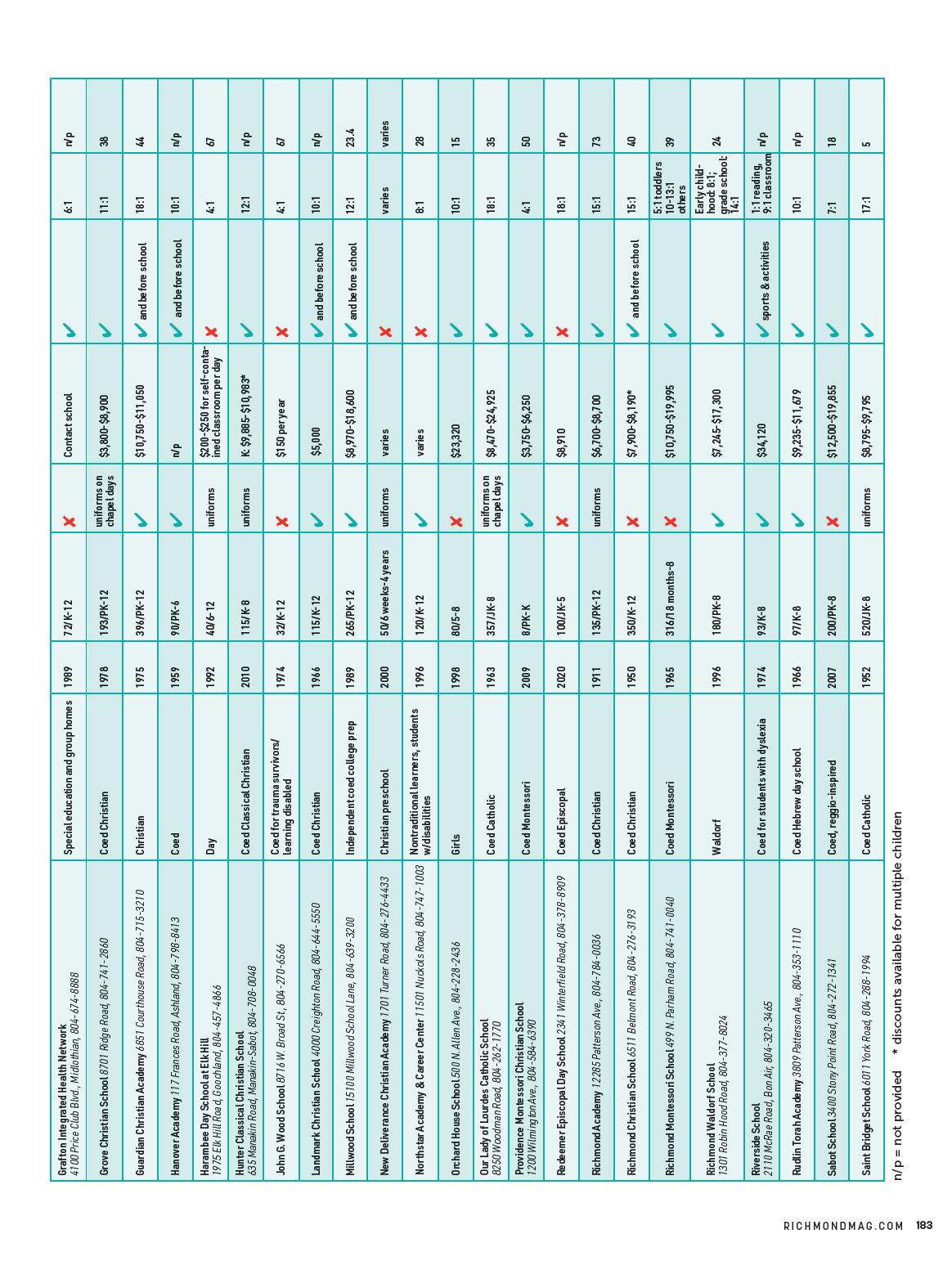

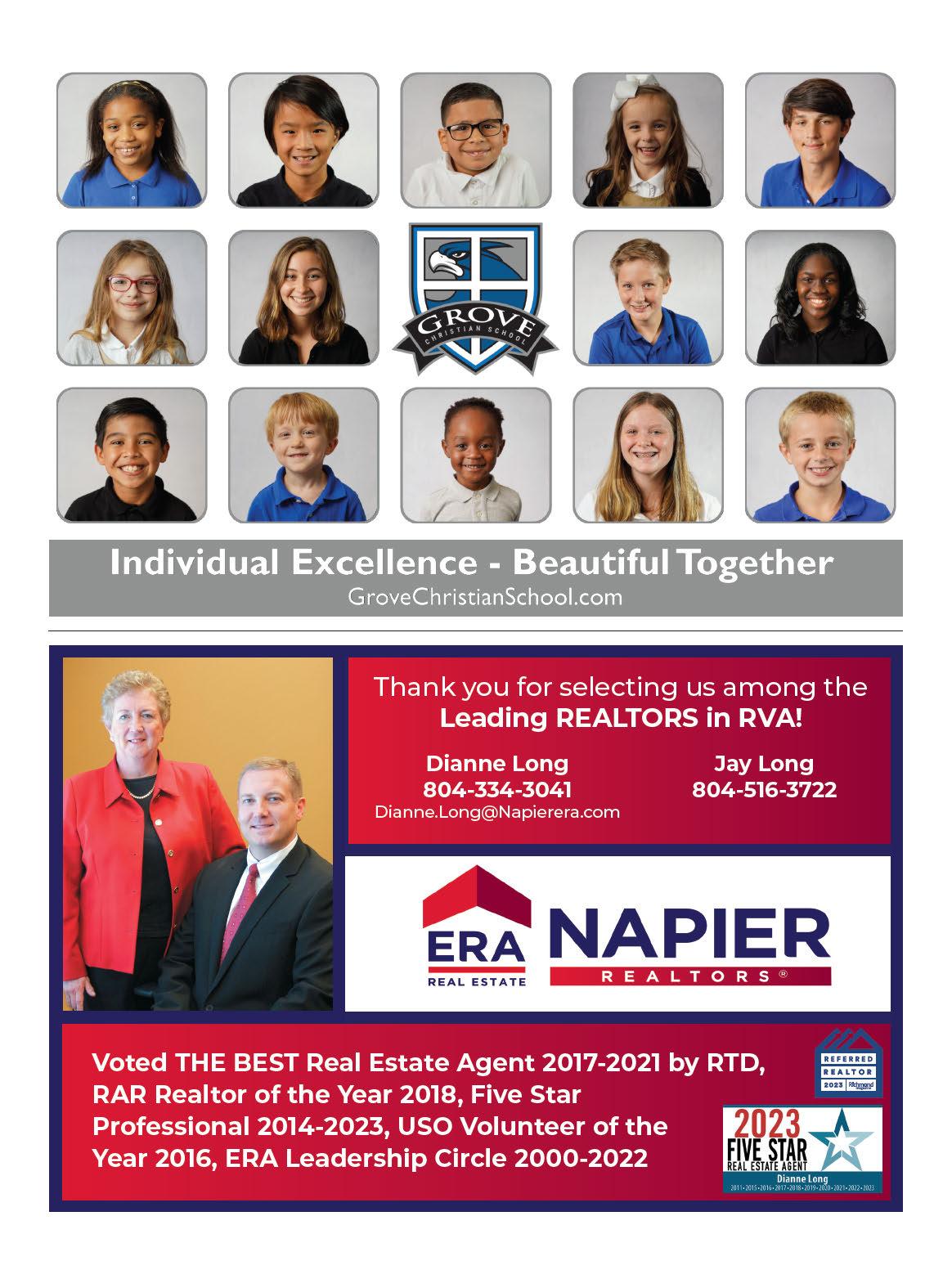




ith museumworthy fashion design, Riva Samee, a 16-year-old rising senior at St. Catherine’s School, is adding further evidence to fashion icon Ralph Lauren’s notion that “fashion is about something that comes from within you.”
She recently completed a 12-week course at the Virginia Museum of Fine Arts through its Teen Stylin’ program, where she worked with local fashion designers and studio art instructors to construct unique, wearable works of art featuring unconventional materials that were inspired by items in the VMFA collection.
Riva’s a nity for fashion began at an early age. “I would gravitate toward fashion books and games and just be fascinated looking in my mom’s closet,” she says. However, she was uncomfortable expressing herself through her family’s Pakistani culture. “I was the only South Asian girl in my elementary school.”
Moving frequently as a child, Riva a ended three elementary schools and faced the same issue at each. “I felt very insecure whenever people would come over” and see her grandmother dressed in traditional Pakistani clothing, she recalls. “Around my American friends, I didn’t want them seeing that side of me.” Riva says she would try to hide her Pakistani side through her choice of clothing. “Whenever I look at other people’s clothes, that’s an expression of their iden-
tity. I subconsciously used that to mask my true identity.”
A er making her own outfit for Eid, a Muslim holiday, at age 9, Riva was encouraged to pursue her interests as a potential career. With her parents’ support, she a ended a program for high schoolers at the Parsons School of Design in New York City at age 15.
Earlier this year, her art teacher at St. Catherine’s encouraged Riva to apply for VMFA’s Teen Stylin’ program. Between signing up and being accepted, she joined her family on a trip to Pakistan. “It was a great feeling to understand that part of my culture, where I didn’t feel like an outsider to it,” she says.
The trip convinced her that she wanted to connect her two “identities” in clothing.
The program’s theme, ”Illusion,” spurred Riva to work on an outfit that literally fused Pakistani history and culture with her American identity based on a statue of an Egyptian pharaoh assigned to her by the program. e dress uses Pakistani rice bags and CDs. Riva says the bags and CDs are a visual metaphor for facades and the illusion of a stable society and represent hiding and reflecting “something o of yourself onto something else” to echo her own work embracing her Pakistani identity.
Riva completed the program in May and plans to pursue a career in fashion and design. Her advice to others who want to pursue their passions is to “get uncomfortable” — to step out of your comfort zone to see if you can pursue your dreams. Riva says it’s all worth it.






